













By David Rullo | Senior Sta Writer
Yeshiva Schools of Pittsburgh is once again affiliated with Merkos L’Inyonei Chinuch, the educational arm of Chabad-Lubavitch.
The school was delisted by the organization earlier this year and, as a result, lost its affiliation with Chabad of Western Pennsylvania.
According to an Aug. 6 announcement, Yeshiva Schools will retain its existing “board-operated governance structure with added oversight to ensure that it remains dedicated to fulfilling its mission of operating a dual curriculum Jewish day school rooted in the fundamental tenets of Chabad-Lubavitch.”
The roots of the tension between the Yeshiva Schools and the Lubavitch Center go back to 2019, when the Jewish Federation of Greater Pittsburgh requested a governance audit of the school.
At its conclusion, auditors recommended Yeshiva Schools decouple from the Lubavitch Center.
In July 2020, the organizations signed a Perpetual Cooperation Agreement, which was amended in 2021 to address several issues not in the original agreement, such as the ownership of sefer Torahs and religious books, insurance, security, janitorial service, building maintenance, operation of the mikvah and the sale of a dormitory.
Later the same year, Rabbi Yossi Rosenblum was appointed Yeshiva’s new CEO and head of school, succeeding Rabbi Yisroel Rosenfeld. Rosenfeld remains the head shaliach of Chabad of Western Pennsylvania and the rabbi of the Lubavitch Center.
As the two organizations worked to implement their Perpetual Cooperation Agreement, disagreements arose that were brought to a rabbinic arbitrator, according to Chaim Oster, Yeshiva’s board president. Most of those issues were resolved, but several remained, including a bequest valued at $560,000.
When the arbitrator resigned in 2023, Yeshiva Schools wanted the remaining matters to be decided by a secular court while the Lubavitch Center believed Jewish law required the matters to be brought before a beis din, or Jewish court.
Ultimately, Merkos listed Yeshiva’s unwillingness to appear before a beis din as the reason it delisted the school. Yeshiva filed for injunctive relief in the Court of Common Pleas of Allegheny County, alleging that the Perpetual Cooperation Agreement and its addendum are in full effect and sought to specify: the sale of 2142 Wightman from the Lubavitch Center to Yeshiva Schools for $300,000; certain donations should be given to Yeshiva by the Lubavitch Center; and
By David Rullo | Senior Sta Writer
Those hoping the University of Pittsburgh’s Working Group on Antisemitism had already provided the school’s administration with recommendations to improve campus safety for Jewish students might be disappointed.
Announced in December 2024, the working group was created to replace an ad hoc committee on antisemitism proposed during a Nov. 16 faculty assembly meeting, which met immediate push back from the university’s Equity, Inclusion and AntiDiscrimination Advocacy Committee.
At that time, Jennifer Murtazashvili, director of the university’s Center for Governance and Markets, who was selected as co-chair of the ad hoc committee, was announced as the co-chair of the working group. Her position was later changed to vice chair when Kathleen Blee, the former dean of Pitt’s Dietrich School of Arts & Sciences, was announced as the new chair at a March 20 Senate Council meeting.
While some might have expected visible signs of the group’s work as students arrived on campus for the fall semester, Blee said that was never the intention.
“We convened at the end of the spring semester and we had several meetings then. We had several meetings over the summer and now, starting with the fall semester, we’ll be meeting even more intensively,” she said. The working group, she said, includes students who weren’t available during the summer, but now that campus life is back in full swing, the intention is to “double our efforts in the fall and spring semesters, once everyone is back in place.”
Blee said she is unable to discuss what the group accomplished over the summer because, like most Pitt committees, the proceedings are confidential.

By Adam Reinherz | Senior Staff Writer
Someone tell Paul Bunyan, the machines won again. During the past two years, leaders of Pittsburgh’s Jewish day schools have changed their attitude and approach to artificial intelligence. Though educators once entered the school year decrying — and even attempting to outlaw — ChatGPT and similar apps capable of solving equations, creating images and video, and even drafting or translating texts, they now boast the tools’ merits.
The shift stems from increased appre ciation for what technology is and is not, according to Rabbi Yossi Rosenblum, CEO and head of school at Yeshiva Schools of Pittsburgh.

edited it and brought it to the board for approval.
Asking systems or software to complete tasks only takes one so far, Rosenblum said. “You have to take it and make it yours. You have to add soul to it and add a personal touch.”
Rosenblum and his colleagues often use AI for development, human resources and to help draft policy.
Regarding fundraising, “we have great grant writers, but we’ve used it to write grants,” Rosenblum said. Similarly, when it comes to specific messaging, “we have good writers, but we will use it to come up with narratives for our drives.”
AI, Rosenblum said, has been especially helpful for articulating school procedures.
For field trips and other off-campus excursions, a policy at Yeshiva Schools regarding transportation — eligible drivers, required vehicles — was initially composed by AI. Rosenblum then took the text,
The policy was adopted, “but it started with AI,” he said.
Community Day School’s Casey Weiss said the about-face toward AI occurred because using the systems “has become the norm.”
In her work as the Jewish day school’s head, Weiss relies on ChatGPT largely for speech writing.
She often begins by looking through the Torah for an appropriate verse, or a school database for past donors, she said. Once she’s found a specific detail relevant for her address, AI helps by creating supplemental copy.
The key word in understanding AI’s role at school, according to Weiss, is “resource.”
Both for educators and students, “we cannot outsource all we do to AI,” she said.
Yikara Levari, Hillel Academy of Pittsburgh’s interim principal and academic
director, said she and her colleagues are committed to understanding how educators “can utilize AI to be more efficient.”
As an administrator at the Jewish day school, she said, she’s aware of not only students’ use of ChatGPT but its adoption among educators.
“I know a lot of my colleagues use it to create rubrics and lesson plans,” she said.
As a lead-up to Hillel Academy’s first day of school, and in an effort to promote professional development, Levari invited Rabbi Baruch Noy, a Long Island-based expert who has worked with more than 200 schools on approaches to integrating technology into classrooms.
When considering how best to use AI, the “human element” must be considered, according to Noy.
Writing in the Journal of Jewish Day School leadership, a publication from the Consortium of Jewish Day Schools, Noy noted that behind every AI text created

SUBSCRIPTIONS
subscriptions@pittsburghjewishchronicle.org 412-687-1000, ext. 2
TO ADVERTISE advertising@pittsburghjewishchronicle.org 412-687-1000, ext. 1
EDITORIAL DEPARTMENT
Email: newsdesk@pittsburghjewishchronicle.org
BOARD OF TRUSTEES
Evan H. Stein, Chair
Evan Indianer, Vice Chair
Derek Smith, Treasurer
Gayle R. Kraut, Secretary
Gail Childs, Dan Droz, Malke Steinfeld Frank, Seth Glick, Tammy Hepps, Judith Kanal, Cátia Kossovsky, Charles Saul
GENERAL COUNSEL
Stuart R. Kaplan, Esq.
Jim Busis, CEO and Publisher 412-228-4690 jbusis@pittsburghjewishchronicle.org
EDITORIAL
Toby Tabachnick, Editor 412-228-4577 ttabachnick@pittsburghjewishchronicle.org
Adam Reinherz, Senior Staff Writer 412-687-1000 areinherz@pittsburghjewishchronicle.org
David Rullo, Senior Staff Writer 412-687-1000 drullo@pittsburghjewishchronicle.org
ADVERTISING
Amy Weiss, Account Executive (412) 613-0697 aweiss@pittsburghjewishchronicle.org
“AI doesn’t have a soul … It’s a helpful tool to be more efficient, but you have to take whatever AI gives you and take it to the next level.”
―RABBI YOSSI ROSENBLUM
is a “human element” guiding the platform to produce an “optimal” response. “In other words, humans are directing the nature and content of the final product even if they are not producing the end result.”
Ensuring a text rendered by AI matches one’s stance on the subject is essential, Noy added.
“AI learns your preferences and style over time,” but one shouldn’t forget certain “core values,” Rosenblum said. “AI doesn’t have a soul … It’s a helpful tool to be more efficient, but you have to take whatever AI gives you and take it to the next level.”
The imperative, he continued, is one educators, students and even folk heroes should easily recognize: “Keep toiling.” PJC
Adam Reinherz can be reached at areinherz@pittsburghjewishchronicle.org.
phone number: 412-687-1000 Subscriptions: 412-687-1000, ext. 2
PRODUCTION Jeni Mann Tough Production Manager Carl Weigel Art/Production Coordinator Subscriptions subscriptions@pittsburghjewishchronicle.org 412-687-1000, ext. 2
Published every Friday by the Pittsburgh Jewish Publication and Education Foundation 5915 Beacon St., 5th Floor Pittsburgh, PA 15217 Phone: 412-687-1000
POSTMASTER: Send address change to PITTSBURGH JEWISH CHRONICLE, 5915 BEACON ST., 5TH FLOOR PITTSBURGH, PA 15217 (PERIODICAL RATE POSTAGE PAID AT PITTSBURGH, PA AND AT ADDITIONAL MAILING OFFICES) USPS 582-740
Manuscripts, letters, documents and photographs sent to the Pittsburgh Jewish Chronicle become the property of this publication, which is not responsible for the return or loss of such items.
The Pittsburgh Jewish Chronicle does not endorse the goods or services advertised or covered in its pages and makes no representation to the kashrut of food products and services in said advertising or articles. The publisher is not liable for damages if, for any reason whatsoever, he fails to publish an advertisement or for any error in an advertisement. Acceptance of advertisers and of ad copy is subject to the publisher’s approval. The Pittsburgh Jewish Chronicle is not responsible if ads violate applicable laws and the advertiser will indemnify, hold harmless and defend the Pittsburgh Jewish Chronicle from all claims made by governmental agencies and consumers for any reason based on ads appearing in the Pittsburgh Jewish Chronicle
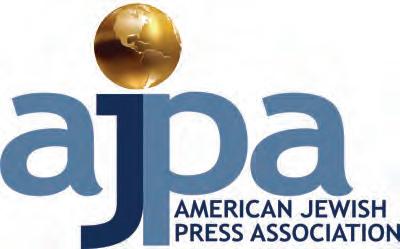
By Adam Reinherz | Senior Staff Writer
The international field got a little smaller for softball phenom Izzy Zober. The Fox Chapel teen, who’s played in Italy, Prague and across the U.S., recently returned from Spain, where she and fellow members of Team Israel competed in the World Baseball Softball Confederation U18 Women´s Softball European Championship.
The July 21-26 tournament featured 17 crews from several locales, including Great Britain, Hungary, Ireland and Sweden.
As a member of one of the tournament’s youngest squads, Izzy, 14, said she expected fierce competition.
Little did she realize her loudest opponents never stepped foot on the diamond.
Shortly before the tournament began, Team Israel was banned from the host city’s fields, her father, Yarone Zober, told the Chronicle.
In lieu of playing in Navarra, Team Israel was relegated to Zaragoza, a Spanish city nearly two hours south. And, apart from the imposed isolation, the team was “rushed in and out” of games in order to avoid protestors, Izzy said.
Whether during at bats or pitching, agitators tried disrupting each game with war-related chants, loud noises and other distractions, Yarone Zober said.
Izzy and fellow teammates largely ignored the off-field antics.
“It wasn’t really something that affected us,” the right-handed pitcher, who also plays first base, said. The important aspect was that “we got to play in Spain and we had the opportunity to represent Israel, especially at this time.”
Still, the fact that adults would venture out to disturb the actions of teenage softball players is odd, she said.


“It was a waste of their time,” she said. “There’s no reason to show up.”
Izzy said she understood the actions were “connected to the war, but that has nothing to do with us playing softball.”
Yarone Zober said he was impressed by the athletes’ reactions.
“It could have been a pretty scary experience — and I think the average kid who was subjected to this sort of thing would not have reacted or responded like they did,” he said. “These girls took the field every day and did their best and stood tall. And many of them, in what I think of as true Jewish fashion, didn’t just stand up, but they reacted with poise and strength and even a sense of humor.”
Following a particularly clamorous game, one athlete brought a shofar and played it “in front of everybody who had been making noises at our team the whole game,” he continued. “It was really a showing of pride and a showing of Jewish strength in the face of those who would like Israel and probably Jews not to exist.”
For Izzy, playing softball and representing Israel — the Fox Chapel teen is a dual citizen — weren’t the only highlights of her time abroad.
She said she and teammates participated in a Friday night Shabbat service in Zaragoza before going out for sushi. And they enjoyed seeing Jewish and non-Jewish residents of the city and members of Sefarad Aragón, an independent group that promotes knowledge and appreciation of Jewish, Hebrew and Israeli culture, demonstrate support for the blue and white-clad athletes.
“They would come out every game, and they would wave the Israeli flag and cheer us on,” Izzy said.
Now back in Pittsburgh, Izzy’s summer of softball continued with participation in the JCC Maccabi Campus Games. Throughout the Aug. 3-8 event, Izzy was joined by several
camaraderie, competition and Jewish pride, an element of the Games was showcasing Pittsburgh. On Aug. 5, athletes, coaches and spectators traveled to PNC Park to watch the Pirates take on the San Francisco Giants. Before the first pitch, and as part of Jewish Heritage Night, Games participants were welcomed onto the field.
Yarone Zober, who’s traveled the world cheering on his daughter and her teammates, said there’s something special about being back on one’s home turf.
“I love Pittsburgh and I love showing it off,” he said. Whether it’s going to a Pirates game, Bakery Square, the Strip District or just driving visitors around and “having them look at the houses of Pittsburgh, and they go, ‘Whoa, what is that? Is that a mansion?’ And you say, ‘No, that’s a church,’ you just sort of forget the culture,” he said. Sharing Pittsburgh with those who’ve never been here before is a “whole different scenario; we’re so used to Pittsburgh, but for them — seeing Pittsburgh through the eyes of these Israeli kids — you learn to fall in love with it again.” PJC
Adam Reinherz can be reached at areinherz@pittsburghjewishchronicle.org.

We take pride in a holistic approach, streamlining design & construction for a smooth, e cient, and collaborative experience.
If you're ready to get your next design project o the ground, we want to hear from you! Contact us today for a free consultation to determine if J.A. Lott Design & Associates can bring your vision to life.
“When an unexpected life event meant we had to move to a single- oor home, we turned to J.A Lott Design & Associates. eir thoughtful design made our new space not only practical and accessible, but also lled with the warmth, color, and character that re ect the life we’ve built together.”
By Benyamin Cohen | Forward
This story was originally published on November 18, 2024 and was updated to reflect the latest Neo-Nazi activity.
Armed neo-Nazis, shouting “white power!” and carrying swastika flags, marched through downtown Indianapolis on Saturday. This follows similar incidents in Ohio in February and last October.
“Almost every single weekend, white supremacists are rallying in some neighborhood,” Oren Segal, vice president of the Anti-Defamation League’s Center on Extremism, said in a Nov. 2024 interview. The group’s data found 282 such events in 2023 and more than 750 since 2020.
The regularity with which they happen can both numb and instill fear in Jewish communities. Segal said they are not part of a rising trend of antisemitism in the wake of the Oct. 7 Hamas attack in Israel, but have been occurring since 2016, “around the time of the first Trump administration.”
Segal said these rallies are usually organized by small groups hoping to get attention online, where they can attract new recruits. Additionally, the marches are sometimes the result of a turf war, almost a “soap opera” between competing

white supremacist groups.
The Aryan Freedom Network, one of the most active neo-Nazi groups in the country, has become a driving force behind many



of these rallies. Based in Texas but with chapters in dozens of states, the network mixes Nazi symbols with Klan-style theatrics and Christian nationalist rhetoric. Extremism researchers say its growth in recent years reflects how white supremacist ideas are being repackaged for the digital age — quick-hit marches designed less to win streets than to flood social media with propaganda and attract new recruits.
Antisemitic neo-Nazi marches happen all the time.
While white supremacist rallies are frequent, “that doesn’t mean it’s not a concern,” Segal said. “But having small groups of white supremacists show up in a community, march through town with swastikas and other hateful symbols is actually quite normal in this country.”
The neo-Nazi march that had the most lasting impact was the one in August 2017 in Charlottesville, Virginia. Called the “Unite the Right” rally, it was organized to protest the removal of a statue of
Robert E. Lee, the Confederate general. Among the hundreds of attendees were a who’s who of extremists, including farright militias, Klansmen, neo-Nazis and Richard Spencer, a supporter of President Donald Trump and a college friend of Trump’s Deputy Chief of Staff Stephen Miller. The following day turned violent when rallygoers clashed with counterprotesters. Dozens were injured and a white supremacist rammed his car into counterprotesters, killing one.
In a news conference afterward, Trump famously said, “you also had people that were very fine people, on both sides.”
These marches are mostly organized by small groups.
Marches similar to the one in Indianapolis — led by a small group hoping to cause a big ruckus — are what the ADL sees on a regular basis. Some recent examples: outside a performance of “The Diary of Anne Frank” in Michigan; outside the Broadway

NOWPARTNERING WITH

NOW PARTNERING WITH NOWPARTNERING WITH
NOWPARTNERING WITH

NOWPARTNERING WITH
Are you an ischemic stroke survivor interested in improving arm and hand function? Vivistim may be right for you!


Areyouan ischemicstroke survivorinterestedin improving armandhandfunction?Vivistim mayberightforyou!
Areyouan ischemicstroke survivorinterestedin improving armandhandfunction?Vivistim mayberightforyou!
WITH Areyouan ischemicstroke survivorinterestedin improving armandhandfunction?Vivistim mayberightforyou!
Areyouan ischemicstroke survivorinterestedin improving armandhandfunction?Vivistim mayberightforyou!
Call us at 412-414-1988 for more info or to schedule an evaluation!
www.tolifefitness.com
Areyouan ischemicstroke survivorinterestedin improving armandhandfunction?Vivistim mayberightforyou!
NOWPARTNERING WITH Areyouan ischemicstroke survivorinterestedin improving armandhandfunction?Vivistim mayberightforyou!
Callusat 412-414-1988 formoreinfoorto scheduleanevaluation! www.tolifefitness.com
Callusat 412-414-1988 formoreinfoorto scheduleanevaluation! www.tolifefitness.com
Callusat 412-414-1988 formoreinfoorto scheduleanevaluation!
Callusat 412-414-1988 formoreinfoorto scheduleanevaluation!
www.tolifefitness.com
Callusat 412-414-1988 formoreinfoorto scheduleanevaluation!
Callusat 412-414-1988 formoreinfoorto scheduleanevaluation! www.tolifefitness.com
March:
Continued from page 4
theater hosting the Tony-winning “Parade,” a musical about antisemitism; and multiple times in front of Disney World in Orlando.
“I don’t think these groups are cooperating in the same way that they did around Charlottesville,” Segal said. Instead, it’s mostly infighting between white supremacist groups “competing for attention.”
Sometimes these marches are held to start a turf war.
The marchers at a 2024 march in Columbus, Ohio belonged to a newly formed white supremacist group based out of St. Louis, Segal said. A rival group is based in Ohio. “Essentially, this was perhaps part of a turf war,” Segal said. He called it a “soap opera amongst white supremacists,” where
and out,” Segal said. “It’s to create imagery and propaganda that then has an impact well beyond the community that they target.”
Videos of the events are quickly shared online. “This is what they want,” he said. “One of their ultimate goals is to get this attention. If there was no social media, we would not probably see as many of these rallies.”
Segal said news organizations should consider whether or not to publish the names of the small groups behind the marches because it could “potentially give oxygen” to them. For its part, the ADL has sections on its website devoted to each of these groups, because it believes that “sunlight is the best disinfectant,” Segal said, even though some of these groups may see it as a badge of honor to be profiled by the ADL.
“One of their ultimate goals is to get this attention. If there was no social media, we would not probably see as many of these rallies.”
―OREN SEGAL
one group “is trying to antagonize another by showing up in their area.”
The marches tend to co-opt current events.
During the height of the presidential election campaign last summer, the focus turned to Springfield, Ohio, after then-vice presidential nominee JD Vance, a senator from the state, repeated a debunked claim that Haitian immigrants there were eating pets. During a debate with Vice President Kamala Harris, Trump repeated the claim and shortly afterward, five different white supremacist groups — all sharing an anti-immigration ideology — descended on Springfield, Segal said.
“These groups take their cues from the public discussion,” he said. “We’ve also seen, since Oct. 7, white supremacists adopt anti-Israel slogans as well. They’re always going to try to exploit the news and a crisis in order to get attention.”
The events are meant to be quick and newsy.
The rallies are usually not announced in advance; a spontaneous gathering is less likely to draw local authorities or counterprotesters. “They’re quick: get people in
‘Rinky dink’ groups with serious consequences
These groups are all “very similar in terms of not only their beliefs, but their tactics,” Segal said. “But we don’t really have the luxury to call them rinky dink.”
He explained that these small marches are used to recruit people online. “You never know who online is going to see what they do and say, ‘Oh, I need to not only be part of this, but take it to the next level.’”
He said this is what led to the mass shootings at synagogues in Pittsburgh (2018) and Poway, California (2019), and at supermarkets in El Paso (2019) and Buffalo (2022). None of the shooters “were card-carrying members of any of these alphabet soup of groups, but they subscribed to the exact same ideology,” Segal said. “Hundreds of these types of events, even as small as they are, are just normalizing the hatred of Jews and other minority communities. And there are consequences to that.” PJC
This story was originally published on the Forward. To get the Forward’s free email newsletters delivered to your inbox, go to forward.com/newsletter-signup
CONTEST —
The Pittsburgh Jewish Chronicle is looking for a creative and colorful holiday illustration to be featured on the cover of its Rosh Hashanah issue! Entry deadline is 10 a.m. on Sept. 9, 2025.
All ages are welcome to participate. Submit your art, along with your name, the art’s title, your city, email address and phone number. If the entry is from a child, please include the child’s age and parent’s name. All entries must be submitted via email.

Submit entries to newsdesk@pittsburghjewishchronicle.org, and write “Rosh Hashanah art” in the subject line. PJC

Wednesday, September 10, 2025 • 5:30 pm
JCC Squirrel Hill • Levinson Hall
5738 Forbes Avenue • Pittsburgh, PA 15217
Rogal-Ruslander Leadership Award
Eric Kroll
S. J. Noven Koach Award: Maccabi Games Co-Chairs
Stefani Pashman and Jeremy Feinstein
David and Dory Levine
Linda Simon
Ida and Samuel Latterman Volunteer Mitzvah Award
Patricia Siger
Todd E. Reidbord
Lillian Goldstein Senior Adult Volunteer Award
Robin Hausman
Loving Kindness Award
Rev. Dr. Asa J Lee, The Pittsburgh Theological Seminary
Caplan-Lieber Human Relations Award
Ivy Freshwater, Montour High School
Samihah Saleem, South Fayette Township High School
JCC Volunteer of the Year through The Jewish Chronicle
Amy Mallinger
Submit calendar items on the Chronicle’s website, pittsburghjewishchronicle.org. Submissions also will be included in print. Events will run in the print edition beginning one month prior to the date as space allows. The deadline for submissions is Friday, noon.
FRIDAY, AUG. 22
Gather in Rodef Shalom’s Biblical Garden for a 20s and 30s Kabbalat Shabbat. Get to know other young Jewish professionals and close out the week with apps, wine and great company. Registration required. 7 p.m. 4905 Fifth Ave. rodefshalom.org/lateshabbat.
SUNDAY, AUG. 24
Join Chabad of the South Hills for Tee O Together, a fun afternoon at Top Golf. 1 p.m. 400 Presto-Sygan Road, 15017. chabadsh.com/golf.
SUNDAYS, AUG. 24 ― DEC. 28
Join Chabad of Squirrel Hill for its Men’s Tefillin Club Services and tefillin are followed by a delicious breakfast and engaging discussions on current events. 8:30 a.m. 1700 Beechwood Blvd. chabadpgh.com.
Join a lay-led online Parashah study group to discuss the weekly Torah portion. No Hebrew knowledge needed. The goal is to build community while deepening understanding of the text. 8:30 p.m. For more information, visit bethshalompgh.org/online-parashah.
MONDAY, AUG. 25
Join the 10.27 Healing Partnership and prepare for the High Holidays with community, care and learning at Rosh Chodesh Elul. Explore unity with Jewish learning with Rabbis Hindy Finman and Alex Greenbaum, and practice mindfulness through acupuncture or forest meditation before gathering for a shofar blowing. 6 p.m. Jewish Community Center of Greater Pittsburgh, 5738 Forbes Ave. 1027healingpartnership.org/rosh-chodesh-elul-mindfulness-and-jewish-lear.
MONDAYS, AUG. 25 ― SEPT. 29
Join the 10.27 Healing Partnership for Roll for Insight:
Community-Building Role-Playing Games. Meet every other week to connect and grow with new friends through playing tabletop role-playing games designed to inspire emotional depth. They will use RPGs to explore the intersection of identity, emotional resiliency and games to fight isolation and disconnection, and to meet new people and form friendships. Free. No experience required. 16 and up. 5:30 p.m. Jewish Community Center, 5738 Forbes Ave. 1027healingpartnership.org/rpg-club.
MONDAYS, AUG. 25–DEC. 29
Join Congregation Beth Shalom for a weekly Talmud study. 9:15 a.m. For more information, visit bethshalompgh.org.
Join Temple Sinai for an evening of mahjong every Monday (except holidays). Whether you are just starting out or have years of experience, you are sure to enjoy the camaraderie and good times as you make new friends or cherish moments with long-term pals. All are welcome. Winners will be awarded Giant Eagle gift cards. All players should have their own mahjong cards. Contact Susan Cohen at susan_k_cohen@yahoo.com if you have questions. $5. templesinaipgh.org.
TUESDAYS, AUG. 26 ― SEPT. 16
Tree of Life Congregation will be o ering a series of four classes to prepare for the upcoming High Holidays In these sessions led by Rabbi Je rey Myers, attendees will view the film “Bruce Almighty,” followed by discussion questions. Free. 7 p.m. Rodef Shalom Congregation, 4905 Fifth Ave. treeoflifepgh.org.
WEDNESDAYS, AUG. 27 ― DEC. 31
Temple Sinai’s Rabbi Daniel Fellman presents a weekly Parshat/Torah portion class on site and online. Call 412-421-9715 for more information and the Zoom link.
Bring the parashah alive and make it personally relevant and meaningful with Rabbi Mark Goodman in this weekly Parashah Discussion: Life & Text. 12:15 p.m. For more information, visit bethshalompgh.org/life-text.

Join Chabad of the South Hills for Baby Loves Shabbat, music and movement for ages 0 to 3. Challah making and Shabbat songs. 3:45 p.m. 1701 Bower Hill Road. chabadsh.com.
WEDNESDAY, SEPT. 3
Join Rodef Shalom Congregation for Biblical Garden Open Door Tours: free, docent-led tours of the congregation’s Biblical Botanical Garden the first Wednesday of the month. 12:15 p.m. 4905 Fifth Avenue. rodefshalom.org/garden.
Join Chabad of the South Hills for a pre-High Holiday seniors lunch. Enjoy A delicious lunch with honey cake, a holiday program and a talk on heart health. Wheelchair accessible. Pre-registration strongly recommended. RSVP at 412-278-2658. $5 suggested donation. 1 p.m. 1701 McFarland Ave. chabadsh.com.
WEDNESDAY, SEPT. 3, 8, 15
Join JFCS for Lunch & Learn: Supportive Parenting for Anxious Childhood Emotions (SPACE), a three-part series designed to empower parents and guardians with skills, tools and confidence to support children with anxiety. All sessions are open to parents/guardians of school age children aged 7-18 still living in the home with a recognized anxiety disorder. Free. 1 p.m. Virtual through Zoom, link provided with registration. jfcspgh.org/event/ lunch-learn-supportive-parenting-for-anxious-child.
SUNDAY, SEPT. 7
Join Chabad of the South Hills for Jewish New York
Visit the Rebbe’s resting place, enjoy a Crown Heights tour, shopping, Chabad world headquarters and a delicious kosher restaurant. Flight and dinner purchased individually. $125. chabadsh.com/jny.
TUESDAY, SEPT. 9
Join StandWithUs for its Pittsburgh Community Reception. Speakers and honorees include keynote speaker Luai Ahmed, student honorees Miriam Levari and Harrison Romero, community honoree the Pittsburgh Jewish Chronicle and a conversation with Rona Kaufman. 5:30 p.m. Location given upon registration. standwithus. com/2025-pittsburgh-event.
WEDNESDAY, SEPT. 10
The Holocaust Center of Pittsburgh presents “Inseparable: A Presentation by Holocaust Survivor Marion
The Pittsburgh Jewish Chronicle invites you to join the Chronicle Book Club for its Oct. 19 discussion of “Sons and Daughters,” by Chaim Grade.
From Amazon.com: “Originally serialized in the 1960s and 1970s in New York–based Yiddish newspapers, Chaim Grade’s ‘Sons and Daughters’ is a precious glimpse of a way of life that is no longer — the rich Yiddish culture of Poland and Lithuania that the Holocaust would eradicate. We meet the Katzenellenbogens in the tiny village of Morehdalye, in the 1930s, when gangs of Poles are beginning to boycott Jewish merchants and the modern, secular world is pressing in on the shtetl from all sides. It’s this clash, between the freethinking secular life and a life bound by religious duty — and the comforts offered by each — that stands at the center of ‘Sons and Daughters.’”
Your hosts
Toby Tabachnick, Chronicle editor
David Rullo, Chronicle senior staff writer
How it works
We will meet on Zoom on Sunday, Oct. 19, at 1 p.m.
What to do
Buy: “Sons and Daughters.” It is available at some area Barnes & Noble stores and
Lewin.” Born in Holland, Lewin survived the concentration camp Bergen-Belsen with her parents and twin brother. One of a handful of families who survived the Holocaust intact, they arrived in New York City in 1947. Today Marion and her brother, according to available data, are the only surviving twins of the Holocaust. 6:30 p.m. Rodef Shalom Congregation, 4905 Fifth Ave. hcofpgh.org/event/ save-the-date-presentation-by-marion-lewin.
SUNDAY, SEPT. 14
The University of Pittsburgh Jewish Studies Program and Rauh Jewish Archives present “O erings of Grief, Offerings of Rage: Revisiting Tree of Life Synagogue and George Floyd Square.” Laura Levitt will explore how people individually and collectively grieve after mass, public tragedies. Her talk will illustrate how the memorial items at the George Floyd and Oct. 27 memorials, when viewed together, can teach us about racism and antisemitism. 5 p.m. JCC Katz Auditorium, 5738 Forbes Ave. 1027healingpartnership.org/event/lauralevitt.
MONDAY, SEPT. 15
Join Chabad of the South Hills for Ladies Pre-High Holiday Fashion Show, an elegant evening where Torah wisdom meets trending style. Delicious refreshments served. 7 p.m. $10 in advance/$15 at the door. The Grey Parrot, 320 Castle Shannon Blvd. Chabadsh.com/ladies.
MONDAY, SEPT. 15 ― WEDNESDAY, SEPT. 17
The Eradicate Hate Global Summit brings together the world’s top minds to build relationships and solutions to reduce hate-fueled violence. 9 a.m., David L. Lawrence Convention Center, 1000 Fort Duquesne Blvd. eradicatehatesummit.org.
THURSDAYS, SEPT. 18 ― JUNE 25, 2026
In the ever-evolving landscape of legal practice, understanding the interplay between faith and governance is crucial for lawyers. Join Rabbi Schi for an engaging CLE series that explores many intriguing questions. Individual classes: $45 with credit/$40 without credit. 8:30 a.m. Virtual. For a complete list of class dates and subjects visit, Jewishpgh.org/event.
SUNDAY, OCT. 19
The Pittsburgh Jewish Chronicle invites you to join the Chronicle Book Club for its discussion of “Sons and Daughters” by Chaim Grade. 1 p.m. Email drullo@ pittsburghjewishchronicle.org for registration link. PJC
from online retailers, including Amazon and Barnes & Noble. It is also available through the Carnegie Library system.
Email: Contact us at drullo@pittsburghjewishchronicle.org, and write “Chronicle Book Club” in the subject line. We will send you a Zoom link for the discussion meeting. PJC
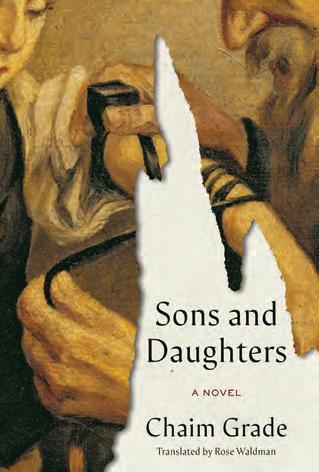

Oct. 7 documentary is reinstated at Toronto film festival after cancellation brouhaha
“The Road Between Us: The Ultimate Rescue” will premiere at the Toronto International Film Festival after all, following a backlash over the festival’s apparent decision to cancel the Israeli Oct. 7 documentary, JTA reported.
TIFF drew criticism last week over its decision to rescind the invitation over concerns about security and about the film’s legal rights to use some of its footage — allegedly the live footage recorded by Hamas terrorists as they attacked Israel.
Last Wednesday, the festival’s director, Cameron Bailey, rejected allegations of censorship and said he had instructed his legal team to work with the filmmakers to resolve open questions. On Thursday, he announced alongside the film’s creator, Barry Avrich, that a resolution had been reached and the documentary, which tells the story of retired IDF General Noam Tibon’s rescue mission of his family during Hamas’ attack on Kibbutz Nahal Oz, would premiere at the festival next month as planned.
The announcement that the film had been removed from the festival lineup had triggered a fierce outcry from Jewish and pro-Israel voices concerned about the marginalization of Israeli voices in public discourse. Tibon and many others decried the idea that Israeli filmmakers should have to secure rights of widely distributed footage created by their attackers. And a member
of the Jewish family that donated land for TIFF’s headquarters said in an open letter that she worried the festival had abandoned its values.
The film’s premiere date will be announced next week, Bailey and Avrich said.
launch ‘Isaac Accords’
The Genesis Prize Foundation, dubbed the “Jewish Nobel,” announced that its $1 million award to Argentinian President Javier Milei will support a new initiative aimed at deepening ties between Israel and Latin America, JTA reported.
Conceived by Milei, “American Friends of the Isaac Accords” takes its name and inspiration from the Abraham Accords, the series of normalization agreements between Israel and several Arab nations.
Milei was the first non-Jew and first head of state to receive the prize in January for his staunch support for Israel and efforts to improve Argentine-Israeli relations. At the time, he said he would donate his winnings to “causes that support freedom and the fight against antisemitism.”
The “Isaac Accords” aim to improve “diplomatic, economic and cultural cooperation” between Israel and Latin American countries, according to the Genesis Prize.
The initiative comes as some Latin American countries, including Colombia, Bolivia and Chile, have downgraded their diplomatic ties with Israel over the ongoing war in Gaza. Milei’s staunch support for Israel has positioned him as a rare bridge on a continent with scarce diplomatic backing for Israel.
Items are provided by the Center for Israel Education (israeled.org), where you can find more details.
Aug. 22, 1952 — First Israel Bonds mission begins
The Development Corporation for Israel, known as Israel Bonds, brings 22 American Jewish leaders to Israel on a 15-day American Champions of Israel Bonds mission, the first of its kind.
August 23, 1969 — Nasser calls for all-out war
Egyptian President Gamal Abdel Nasser, who has turned to devout Muslim practice since the 1967 war, calls for all-out war against Israel in response to the arson attack on Al-Aqsa mosque two days earlier.
Aug. 24, 1954 — Bank of Israel is established
The Knesset passes the Bank of Israel Law, which goes into effect Dec. 1, 1954. It sets up the Bank of Israel as the central financial authority for the state with 10 mi llion Israeli pounds in initial capital.
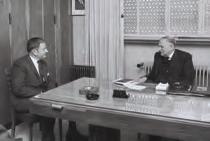
Aug. 25, 2004 — Israel wins first Olympic gold Windsurfer Gal Fridman wins Israel’s first Olympic gold medal at the Summer Games in Athens and thus becomes the first Israeli with multiple Olympic medals. He took the bronze in Atlanta in 1996.
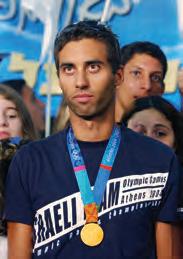
p Wearing his windsurfing gold medal, Gal Fridman is honored during a ceremony upon his arrival at Ben Gurion Airport on Aug. 30, 2004.
Aug. 26, 1955 — Dulles outlines U.S. plan for Middle East
Secretary of State John Foster Dulles reveals a U.S. plan to launch covert peace talks, guarantee the borders of Israel and Arab states, and provide a loan to Israel to pay reparations to Arab refugees.
Aug. 27, 1892 — Jaffa-Jerusalem rail line opens
The first passenger train arrives in Jerusalem from Jaffa. The 53-mile Ottoman railroad line reduces the travel time from the Mediterranean port to the holy city from two days to four hours.
Aug. 28, 1898 — Second Zionist Congress convenes
The Second Zionist Congress opens in Basel with 400 delegates, nearly double the size of the First Zionist Congress. The new participants include Chaim Weizmann, the first president of Israel. PJC
The new NGO is set to launch projects aimed at improving relations with Israel first in Uruguay, Panama and Costa Rica, and will expand its efforts in 2026 to Brazil, Colombia and Chile.
Three Israeli universities ranked in global top 100
The Shanghai 2025 Academic Ranking of World Universities, published last week, includes three Israeli universities in its list of the top 100 universities in the world, JNS reported.
The Weizmann Institute of Science in Rehovot, which suffered significant damage in an Iranian missile strike in June, is ranked 71st, the Hebrew University of Jerusalem 88th and the Technion-Israel Institute of Technology 97th. All three appeared on the 2024 list as well but slipped in their positions this year.
Professor Asher Cohen, president of the Hebrew University, said in response, “The achievement of Israeli academia, with three institutions in the top 100, is particularly impressive in a challenging period, when we are facing unprecedented attacks on the international stage.”
The top five places in the rankings are unchanged from last year, with Harvard University taking first place, followed by Stanford University, the Massachusetts Institute of Technology, the University of Cambridge and the University of California, Berkeley.
The Shanghai Ranking, published annually since 2003, evaluates the research performance of more than 2,500 universities worldwide based on several criteria.
These include the number of Nobel and Fields Medal winners among researchers and alumni, the volume of scientific articles published in top-tier journals and other research-related metrics.
Citing ‘the Jewish imperative’ to act, UJA-Federation pledges $1M for Gaza aid
The UJA-Federation of New York will send $1 million to an Israeli humanitarian group providing aid to civilians in Gaza, JTA reported.
The funds will go to IsraAID, Israel’s largest nongovernmental aid organization, to supply food, medicine and water filtration systems for displaced Gazans. IsraAID has traditionally operated in disaster zones abroad, from earthquake relief in Turkey to aid for Ukrainian refugees, but since Oct. 7 has expanded its work to Israel and now into Gaza.
In a letter to the community, UJA CEO Eric Goldstein condemned Hamas for holding hostages, obstructing aid and provoking the conflict, but said that the Jewish community is nevertheless compelled to help alleviate the suffering of civilians in Gaza.
The pledged donation is far larger than any previously announced aid contributions to Gaza by Jewish groups. Earlier this month, the American Jewish Committee said it would give $25,000 to the Archdiocese of New York to aid in repairs of Gaza’s Holy Family Church, which was damaged by an Israeli strike. Three people were killed and others injured in the incident. PJC
— Compiled by Toby Tabachnick





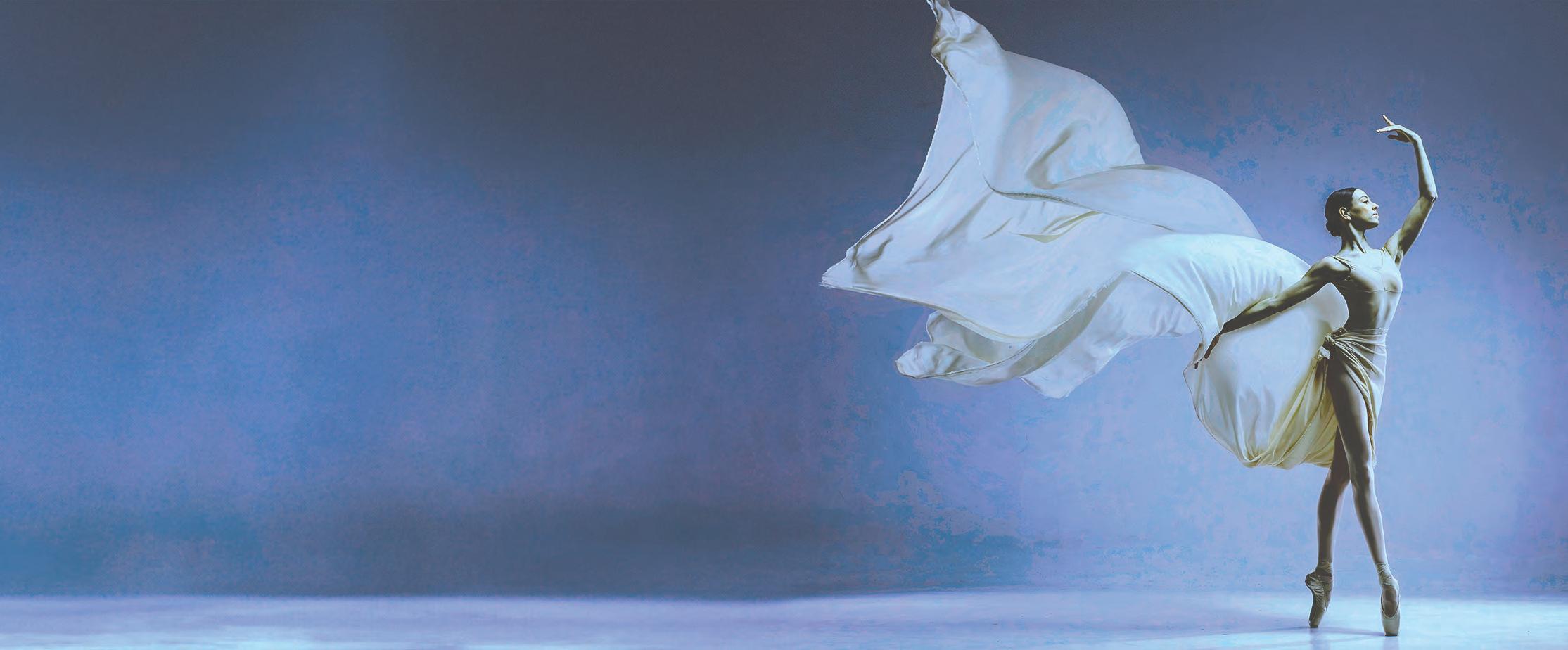
By Emma Riva | Special to the Chronicle
Film Pittsburgh’s new executive director, Shanna Carrick, doesn’t just like movies.
She has a tattoo of Olivia Newton-John in “Xanadu” spinning a laser disc. She’s a paying Cinemark North Hills member who has a go-to order of a Coke Zero and a popcorn, or a whiskey and coke slushie, at its bar. Her LinkedIn profile reads “wants to know your Letterboxd top 4,” which, if you know, you know. (Letterboxd is a popular movie reviewing app.)
So, Carrick is more than a casual movie buff. But it takes more than a movie buff to run a nonprofit at the executive director level. Carrick also brings a decade of experience in strategic planning and operations.
“When I saw on WESA that [former executive director of Film Pittsburgh] Kathryn Spitz Cohan was leaving, I thought to myself: ‘If I don’t apply for this job, I will regret it for the rest of my life,’” Carrick said. That leap turned out to be a fruitful one, as Carrick began her tenure as executive director this summer after an extensive interview process.
Prior to Film Pittsburgh, Carrick worked
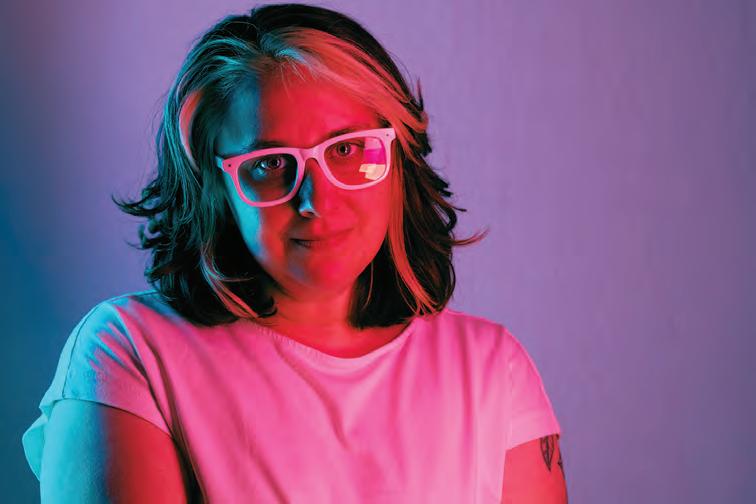
mother’s side, and is raising her daughter Jewish.
“A lifelong Pittsburgher that I am, I have gone to films at Film Pittsburgh, but I don’t remember the specific experience of the marketing of those programs. That’s something I really want to address,” she said. “Brand awareness in this city can be very confusing. What event are you at? Who is behind it? That’s something me and the team will be focusing on in the coming years.”
When she’s not brainstorming strategy for Film Pittsburgh, Carrick enjoys making perfumes. One of her favorite scents is connected to her Jewish identity — labdanum. “In ancient times, farmers would have goats, would trample through a field of rock rose flowers. Then, the farmers would pick the resin out of the goats’ feet and roll it into incense. That incense was then used in the temple,” she explained.
for Deeplocal, a creative technology company based in Pittsburgh, but with national reach.
“Working at Deeplocal meant working for a massive, publicly traded company where things like stocks compliance were a concern. Film Pittsburgh is very different,” Carrick said. “I was also overseeing an IT department at Deeplocal, so at Film Pittsburgh I’ve been seeing where we can create efficiencies for a very small staff.” That includes finding nonprofit discounts for software like Slack or Monday.com to make

Carrick also wonders about finding more corporate sponsors for Film Pittsburgh and taking advantage of Pittsburgh’s increasing status as a destination through events like the 2026 NFL Draft. She participated in a study where community members investigated why Pittsburgh has such a high number of arts organizations per capita, but such a low capacity for funding them compared to larger cities.
“There is not a lot of people in the pool for funding — they’re kind of tapped out since they’re funding everything,” Carrick explained. Before both Deeplocal and Film Pittsburgh, Carrick was director of strategic operations at Pittsburgh Arts and Lectures, so she saw firsthand how arts organizations have to navigate the city’s cultural and financial landscape, often as big fish in small ponds.
Carrick sees a potential connection between Arts and Lectures and Film Pittsburgh, as well — when there’s an author in town, why not screen a film adaptation of their work?
“Pittsburgh is a really fantastic place and the landscape can only get stronger. I call it the hope of being ‘the Cannes of Appalachia,’” Carrick said, referencing Pittsburgh’s nickname as “the Paris of Appalachia.” In Carrick’s new position, she’s making uplifting the city of Pittsburgh a priority. After all, it’s always been her home.
Carrick grew up in the Montour School District in a family with Jewish ancestry on her
Carrick didn’t grow up with religion, but finds a connection to Judaism in other ways, including through her relationship with her daughter, who’s now old enough to attend a Jewish summer camp in eastern Pennsylvania. Carrick’s daughter came home with works of art inspired by Shabbat and other Jewish themes, which she found touching.
Though Film Pittsburgh is known for JFilm, its Jewish film festival, Carrick also wants to elevate one of its other festivals, too: ReelAbilities, which highlights films by or about people with disabilities and originates at the Marlene Meyerson Jewish Community Center in New York. Carrick is neurodivergent herself and sees ReelAbilities as a way for people to understand more about disabled people and their lives.
“These films are for everybody,” Carrick said. “Showing different people and their perspectives is the best way to understand different points of view. Or, film can be armchair travel. But when we’re all in the movie theater together, in silence, that’s something really special.” PJC
ReelAbilities, Film Pittsburgh’s next festival, will run Sept. 4-6 at Point Park University’s Pittsburgh Playhouse and virtually Sept. 5-11 in Pennsylvania, West Virginia and Ohio.
Emma Riva is a freelance writer living in Pittsburgh.


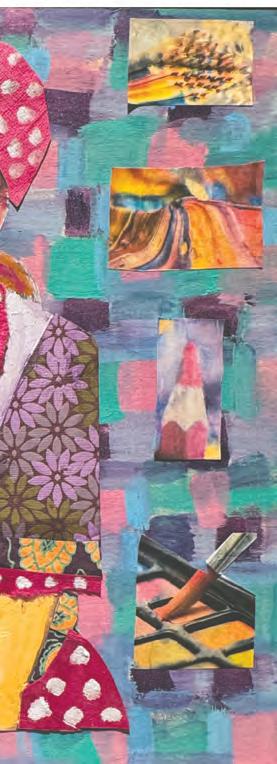


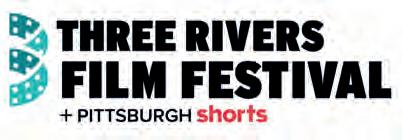



By Adam Reinherz | Senior Sta Writer
An artist with a penchant for color is brightening the Shadyside Arts Festival. Between Aug. 23-24, festivalgoers can enjoy a rich array of acquirable works from Lauren Lazar Stern.
The Jewish artist’s pieces consist of mixed media and collage, with most creations featuring a woman prominently placed in the center.
The subjects, Stern said, are largely inspired by another professional undertaking.
A licensed counselor specializing in eating disorders, women’s issues, trauma and PTSD, Stern, 70, employs traditional therapeutic approaches, art therapy and EMDR (Eye Movement Desensitization and Reprocessing) when working with patients.
“A lot of what I express are the emotions that I feel each day as I work with these girls and these young women to help them find another way, another strategy, another way, to live comfortably,” she said.
Within her art, the Shadyside resident works on paper, wood and canvas. She formerly painted silk but the dyes left her feeling “woozy” and unwell. Stern now mostly uses acrylics. Her color scheme is grand, with frequent returns to purples and reds.
Tucked within the layered images are paint, paper and stories.
One work, “Strong Woman,” features an orange and red-haired figure surrounded by wild animals. Flanking each side of the melancholy subject are written words,
including an excerpt from Carmen Twillie and Lebo M’s “Circle of Life,” a song popularized by Elton John and “The Lion King.” Pasted text includes the black, blue and white “Stronger Together” iconography, which appeared following the Pittsburgh synagogue shooting.
When asked about the recognizable font, Stern noted she and her husband had planned a party marking their anniversary and birthdays on Oct. 27, 2018.
“We had our entire family come in,” she said.
The catered event quickly morphed. An elaborate meal was canceled.




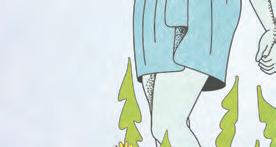



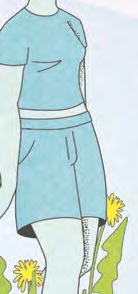


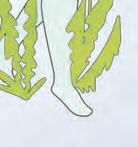


By Emma Riva | Special to the Chronicle
Every September for the last six years, Israeli-born artist Amos Amit has made the trek from Los Angeles to Pittsburgh. The reason? A Fair in the Park, a contemporary art festival in Shadyside’s Mellon Park.
That Amit travels so far for the event is a testament to its quality. This year, he and several other Jewish artists will be displaying and selling their work in the annual outdoor fair, running Sept. 5-7.
While the fair highlights local artists, those from other locales like Amit see it as an opportunity to sell to a new market.
Amit also enjoys the fact that the East End is an epicenter of Jewish life in Pittsburgh.
“I have a work with the tree of life in it, and when I drive into the fair, I always pass by the Tree of Life synagogue,” he said.
Amit’s work is batik, textiles made using a traditional craft process originating in Indonesia. Batik uses beeswax and natural dye on fabric — Amit uses cotton — to create a design. Amit pours the wax into a design and then peels it off, using the wax resistance to sear the design into the fabric.
Batik is labor-intensive and is not easy to learn, but after seeing an art book about batik during his youth in Israel, Amit fell in love. (Though, he noted, he cannot go to the parts of the world batik originates from due to having an Israeli passport — Israeli citizens are barred from entering Indonesia and Malaysia outside of

special visa circumstances.)
The result of the wax resistance and dye is similar to watercolor. “You work from light colors to dark, and decide what you want to keep in the final picture. I have a clothesline in the back of my house, and once they’re dry, I move to the next stage. At the end is when you remove the wax,” Amit explained.
Though originals are large and their prices reflect the labor and training required to do batik, Amit also sells prints of his work, which are affordable to a wider audience.
“I grew up and I wanted to be an artist, but not a starving artist. So, I collected degrees,” Amit said. “I did cultural engineering, then I came [to America] to do landscape architecture since you couldn’t study it in Israel. I completed my thesis,



where I put together plans to build a university in Beersheba. But after that, I chose art full time and I never looked back.”
Now, Amit brings batik all over the world. His favorite subject is nature, inspired by both the lush greenery of the Galilee region where he grew up and the majestic forests of Yosemite National Park in California.
Bobby Harr, a glass artist based in Phoenix, creates primarily Judaica and will be participating in the fair this year as well. His work has been in New York’s Jewish Museum, Los Angeles’ Skirball Center and an array of other galleries.
“This year I will show in over 40 events in 12 states,” Harr said.
Harr uses colorful dichroic glass fused onto black glass to create vibrant Jewish imagery,
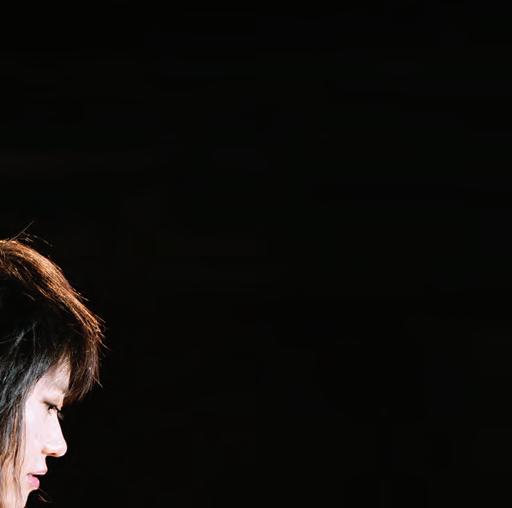
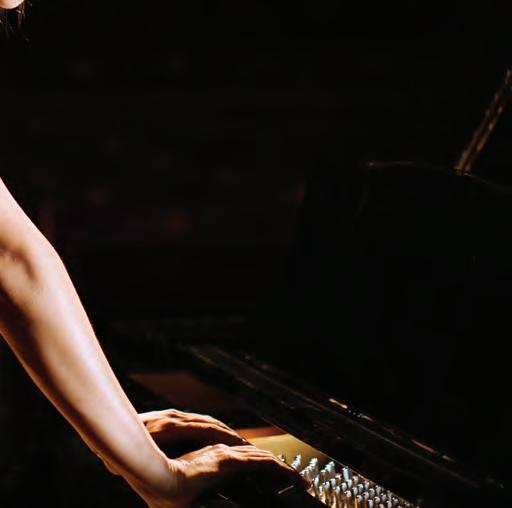
including the chai, tree of life, a Torah scroll and Jerusalem’s Old City. He also has made mezuzot for people’s homes, one of the art forms he’s most famous for.
“My wall pieces are in many Jewish homes around the world,” Harr said.
At the Fair in the Park, Harr will display 45-50 mezuzot. In 2025 alone, Harr has taken his mezuzot to Chicago, Michigan, Maryland and Philadelphia.
But he wasn’t always so prolific. “In junior high school I was told emphatically by my art teacher that I would never be an artist,” Harr said. “But, as you can see, she was wrong.”
At age 48, Harr decided that he would be an artist, and like Amit, he never looked back.
“I finally gave myself permission to allow the artist out. I basically taught myself,” he said. Now, he gets to show the world how his work has grown.
Though artists of all stripes will be participating in the Fair in the Park, the inclusion of Jewish creators and artisans makes it a great opportunity to snag some gifts before Rosh Hashanah, or to simply feel inspired by the ingenuity and craftsmanship Jewish themes can encourage.
“I always do very well at the Fair in the Park,” Amit said. “It’s an easy show to do, it’s not big and grandiose and you have a lot of time to set up and tear down. The people that run it are also very nice and connected with the arts. They’re not just there to make money for themselves.” PJC
Emma Riva is a freelance writer living in Pittsburgh.

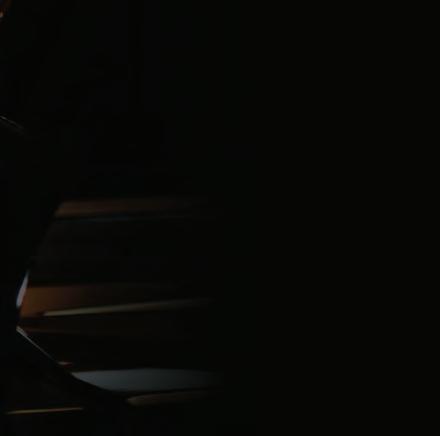

“A lot of what I express are the emotions that I feel each day as I work with these girls and these young women to help them find another way, another strategy, another way, to live comfortably.”
―LAUREN LAZAR STERN
Continued from page 9
“We got pizza, wine and beer, and just invited every friend that wanted to come over to stop by,” she said. “We had candles and we said prayers, and we just all sat together.”
Stern remembers the hourslong experience being both “sad” and “beautiful,” as attendees congregated and recited the Mourner’s Kaddish.
The eclectically dressed person depicted in “Strong Woman,” with pink cheeks and red lipstick, peering away from the viewer, harks back to the synagogue shooting, Stern said.
“We see this sad girl, who just kind of lost everything. And we all lost everything that day: We lost our identity, we lost our spirit. It’s just, oh my God, we have to worry about everything all the time, and feel like we’re not safe and we’re not comfortable,” she said.
In another of Stern’s works, “On Top of the World,” a young woman with cropped brown hair places one hand beneath her chin while resting her other hand by her side. A bird sits on the woman’s shoulder; other birds appear elsewhere. A pink, black and yellow butterfly flits toward painted clouds at the top of the work. Layered beneath the subject are images, including a Volkswagen Beetle.
“We used to have a VW,” Stern recalled. “My mother, she was of course Jewish, and hated German cars, but she had a bug anyway.”



The woman in the image wears a multitiered purple and red-colored crown. Beneath the figure, car and birds are excerpted periodicals.
“During the pandemic, what I would do is just collect newspapers,” Stern said. “It was very hard, you couldn’t really go anywhere to get anything, so I used what I had. We would get all of these catalogs and newspapers and Jewish Chronicles, and I would just rip them up, and paint over them and just paint pieces from them.”
The amalgamated piece points to a desire for freedom and movement with a young woman, front and center, who “was really somewhere else, dreaming,” Stern said.
Those who frequent the artist’s booth during the Shadyside Arts Festival or follow her work online, will find hundreds of pieces with “meaning and purpose,” she said.
Each item may boast a rich collection of color, but the work is about more than mere “fun,” Stern continued. “It talks about the love of life, it talks about the enjoyment of every day.”
Helping convey that message are levels of newspaper print, pictures and paint signaling the “strength of the human spirit,” Stern said. In the search for meaning, there’s a desire “not just to understand the self, but to understand how other people feel and how they respond to you.”
Grasping those interactions requires a process similar to layering and collage, she said. It’s about “connecting.” PJC
Adam Reinherz can be reached at areinherz@pittsburghjewishchronicle.org.


































An audacious collaboration with Attack Theatrefeaturing a cast of 14, Enron will take audiences inside the high-stakes hustle of our financial institutions, revealing the jaw-dropping secrets kept by a company whose shell games shocked the foundations of corporate America.

Written by Anne Washburn
Directed by Andrew
William Smith
A clever, ultimately moving love letter to the theater and to the people who work to create the beautiful, funny, unexpected worlds that live on the stage. Always immersive Quantum takes it to a new level with innovative technology that allows the audience to eavesdrop on the backstage drama of creation.
Staged At One Oxford Centre OCT. 30 - NOV. 23, 2025 Staged At The Mellon Institute APRIL 3 -26, 2026


Guest Columnist
Irwin J. Mansdorf
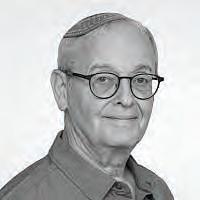
Is every anti-Israel slogan an expression of antisemitism? It’s tempting to answer reflexively, either “yes, of course” or “no, it’s just politics.” Both instincts miss the point. The more instructive question is what happens to people’s views when they’re confronted with facts that test those views. Recent attitudinal research offers a clear pattern: A sizable slice of anti-Israel sentiment softens once reliable information is introduced. Another slice does not budge. The difference between those two groups tells us far more about prejudice, persuasion and the power of peer culture than any viral chant on a quad. Start with a basic observation: A significant minority of Americans (especially younger ones) express anti-Israel positions and support for a Palestinian state. That finding alone doesn’t prove antisemitism. In today’s social climate, identity and solidarity often drive political expression; online networks reward conformity; and many respondents admit they have “no opinion” until a survey forces a choice. In other words, some people aren’t hostile; they’re unprepared.
This is not a flattering diagnosis, but it is a hopeful one. In multiple surveys, when respondents were given concrete information — about incentives for terror, about the denial of Jewish history and rights, about the real-world implications of slogans — stated support for maximalist anti-Israel positions dropped, sometimes by
double digits. One study saw support for a Palestinian state fall by as much as 24 percentage points after clarifying what kind of state was being imagined. Another found that 67.8% of students shifted their view of “from the river to the sea” once they learned what the phrase has meant in practice. Those are not tiny nudges; they’re big swings that separate the merely aligned from the sincerely convinced.
and marshal evidence when it isn’t yet hardened into hate.
Second, education and media literacy. If a third of respondents are “don’t know” or “no opinion,” and another large tranche is swayed by clear information, then the public square isn’t a battlefield of entrenched enemies — it’s a noisy classroom with too few teachers. The antidote to forced-choice politics is not more shouting; it’s
The test is humility – ours and theirs. For those calling out antisemitism, be exact and be fair.
And that brings us to the hard core. Across these data points, roughly one-fifth of respondents remain committed even after factual correction. Call this the “rigidity threshold.” People on this end tend to display confirmation bias: when evidence contradicts their prior views, they don’t adjust — they double down. If the information involves denial of Jewish rights or rationalization of violence against Jews, and the respondent still won’t move, we are no longer in the realm of “pro-liberation” idealism. We are staring at ideological antisemitism. This distinction matters for three reasons.
First, public discourse. Lumping every anti-Israel statement into the antisemitic bucket is analytically sloppy and strategically counterproductive. It alienates potential allies who can be persuaded by facts and moral clarity. Conversely, pretending that nothing in the anti-Israel universe is antisemitic grants amnesty to those who cheer de-Judaization and terror. A functioning society needs both precision and courage: Identify hatred when it’s present,
Guest Columnist
Benjamin Birely
This time it’s different.

In my little over four months in Naples, Italy, as a PhD candidate and researcher, I’ve seen a lot of anti-Israel(i) sentiment and propaganda that’s disturbed me — sometimes I gaslight myself into thinking I’m overreacting; sometimes I know that what I’m seeing and experiencing isn’t normal.
It’s usually the reaction of a local non-Jewish Italian that gives me an indication of how bad it really is. Tragically, and dangerously, local Italian Jews seem numb to the endless expressions of anti-Israel hatred as this horrible war continues.
It started with some colleagues boycotting me when I arrived because I’m Israeli (with no connection to my ideas or politics; I’m also very obviously American, but that doesn’t matter to them). Then it was the artist who refused to sell me one of his pieces five minutes into our interaction unless I said the exact words: “I’m Free Palestine!” after I told him I just arrived from Jerusalem.
Then there were the signs in restaurants and cafes stating: “Zionists not welcome,” “Zionists out!”, which left me carefully scanning the entrance of every place I entered to make sure I was prepared to quickly answer “the U.S.” when asked where I’m from. Then it was the entrance of a major university building proudly declaring “Intifada fino alla vittoria” (i.e., Intifada until victory). Finally, there were the posters of colorful illustrations of Arab fighters trampling bodies of slain IDF soldiers plastered across the
walls of the historical city center with text that read “Death to Colonialism Zionist Invaders.”
Ah, and how could I forget? There was also Keshet, the brave LGBTQIA Italian Jewish organization (not Israeli, nor affiliated with the state of Israel) that was ferociously protested at the annual Pride march open-mic in July for daring to appear openly and publicly with Star of David Pride flags.
structured exposure to facts that make evasions uncomfortable. Yes, discomfort. Cognitive dissonance is not a bug of democratic debate; it’s a feature. It moves the movable.
Third, measurement. Pollsters and institutions should stop reporting raw toplines as if they’re final truth. They should present “post-information” results alongside initial responses. If a respondent supports a Palestinian state in the abstract but withdraws support when told the state in question promotes terror or erases Jewish history, the second answer is the meaningful one. Likewise, if exposure to a slogan’s eliminationist pedigree changes a student’s mind, that should be the figure cited on campus and in the press. We learn far more about the health of our polity by measuring the distance between first impression and informed judgment. There is a cautionary note here. Social networks (both real and virtual) shape norms, especially among adolescents and young adults. Prejudice spreads not only through arguments but through ambiance: the normalization of
certain tropes, the silence that meets certain threats, the applause that greets transgressive chants. People marinated in such environments can drift from performative pose to hardened posture. That’s how ignorance curdles into ideology.
So where does this leave us? With a task and a test.
The task is to insist on specificity. Don’t ask, “Do you support a Palestinian state?” Ask: “Do you support a Palestinian state that condones violence against Jews and denies Jewish rights?” Don’t ask, “Is this slogan inspiring?” Ask: “Do you support what this slogan has historically meant for Jews on the ground?” These are not gotchas; they are clarifiers. They turn sentiment into responsibility.
The test is humility — ours and theirs. For those calling out antisemitism, be exact and be fair. For those chanting the newest moral fashion, be curious enough to interrogate your own side. If, after honest engagement with facts, your view changes, that’s not weakness; it’s integrity. If it doesn’t, and the facts you reject involve Jewish humanity and rights, then we’ve named something darker, and we should be unafraid to say so.
In short, facts don’t cure every bias, but they reveal which biases can be cured. That clarity is a public good — one we should demand in classrooms, newsrooms and every space where slogans travel faster than truth. PJC
Irwin J. (Yitzchak) Mansdorf, PhD, is a fellow at the Jerusalem Center for Public Affairs specializing in political psychology. This article first appeared on The Times of Israel.
The same swastika that this country (the very one in which this flag is displayed in the heart of its third largest city and facing major academic and cultural institutions in the city center) allied itself with and happily followed suit in instituting its own anti-Jewish race laws to appease.
In 1938, when the race laws shook up Italian society and surprised even some of the most ardent fascists, there were nearly 50,000 Jews
Tragically, and dangerously, local Italian Jews seem numb to the endless expressions of anti-Israel hatred as this horrible war continues.
For those on the right who have a knee-jerk reaction to blame Muslim or Arab immigration to Europe, I assure you it wasn’t Islamists who showed up to Napoli Pride to shout Italian Jews off the stage.
However, today, seeing the Nazi swastika hand-drawn or painted on an Israeli flag, neatly positioned over the Star of David, made me sick. Physically ill.
In this cultural and historical context, the weaponization of the swastika to express hatred and outrage toward the state of Israel is different. It took me a moment to absorb what I was seeing.
Someone actually took the time and effort to order an Israeli flag and carefully cover it with red drops to symbolize blood, while inking a swastika over the same religious and national Jewish symbol that the swastika sought to brutally eliminate within our grandparents’ lifetimes … with boycotts, race laws, deportations, camps, forced labor, gas chambers, firing lines, mass graves.
in Italy. Today, there are half that at most. If it weren’t for Iranian Jewish immigrants in the 1950-70s, and several influxes of Libyan Jews fleeing anti-Jewish riots in 1945, 1948 and finally in 1967, the number would be much smaller.
From 1938 onward, non-local Jews were forced out of the country, while Italian Jews were removed from government and military posts, public schools and universities. They were banned from practicing law and medicine, “interracial” relationships between Italians and Jews were outlawed, and Jewish organizations were closely monitored.
These laws were rationalized as protecting fascist Italy against “Jewish internationalists” and communists; against Jewish “greed” and “disloyalty.”
There was no significant popular resistance to these laws — no mass protests, strikes or displays of solidarity. The majority of Italians didn’t blink. They accepted the reality, ate up the propaganda and turned away as Jews were once again forced behind the defensive walls of
their communities.
Between September 1943 and June 1944, the Italian government and police collaborated with the Nazis to round up and deport between 7,500 and 8,000 Italian Jews. They were deported to Auschwitz-Birkenau, Mauthausen and Dachau — and 7,680 never returned, murdered in the camps.
Italy never took accountability for this collaboration.
After the Allied invasion and occupation of Italy and finally Mussolini’s public execution, the fascists went right back into all levels of local, regional and national government after the war, as the Italian mainstream began to craft mythologies of widespread resistance and anti-Nazi activism (I’ve never met an Italian who will admit their grandparents or great-grandparents were fascists — somehow, everyone is descended from a partisan).
And so today, as if two or three generations ago Italian Jews were not deported to concentration camps while most Italians silently stood by, outrage (some of it admittedly legitimate at this point) toward the world’s only Jewish state somehow permits — justifies, demands — the use of the old swastika.
And the worst part? From my experience, I’d wager I’m the only one who even noticed. Thousands of people pass by this same building every day or every week and likely don’t think a thing. PJC
Benjamin Birely made aliyah in 2010 and is based in Jerusalem. He completed a B.A. and M.A. in ancient history at Tel Aviv University, and worked in Israel’s tech industry. He began his PhD in fall 2024. He is currently working on his doctorate in Italy. This article first appeared on The Times of Israel.
Last week, the Chronicle asked its readers in an online poll the following question: “From which ideological camp is antisemitism most dangerous?” Of the 325 people who responded, 26% said far right; 26% said far left; 45% said equally dangerous; and 3% said they weren’t sure. Comments were submitted by 81 people. A few follow.
This is tough. Far right antisemitism may be what most people reach for first: inquisitions and pogroms from Christian antisemites and Nazism, which perpetrated the Holocaust. The Tree of Life massacre and the Poway Passover attack were perpetrated by men identifying with Christianity. The anti-Israel/Hamas war protests from the left have become increasingly violent, peaking thus far with the murder of Yaron Lischinsky and Sarah Milgrim. Hatred allowed to fester, no matter its origin, eventually leads to violence, dehumanization and potentially murder.
Far left antisemitism manifests openly even in their elected politicians, making it more dangerous to all of us.
Both are dangerous but in different ways. The far right is the most assured to commit direct bodily harm, but the far left is more normalized and more likely to discriminate.
It’s all dangerous, but since the Jewish community overall leans left, the corruption from within is a special threat. Pro-Hamas leftists are influencing Jews and damaging the community.
The left will get over their problems with Israel once the Gaza situation is resolved. There will always be antisemitism on the right.
Far right white supremacists. Tree Of Life, Oct. 27, 2018. Enough said.
The far right sight overtly announces its hatred with Nazi Swastikas and the like, while the far left’s stupidity/ignorance/ hatred is a more insidious and subtle danger.
The worst assault on the Jewish people in American history occurred right here in Pittsburgh’s Tree of Life and was committed by a right-wing zealot who believed in the antisemitic “great replacement theory.” Nothing any left-wing students have said or done on campuses about the Gaza war remotely compares.
Most conservatives I know recognize right wing antisemitism. Most liberals I know do not know or care about left wing antisemitism.
Two sides of the same coin. PJC
The shift in the past five years has been remarkable. I never thought I’d fear more for my safety from liberals than from conservatives.
Antisemitism is equally wrong from both political extremes, but far right antisemites tend to be more dangerous as they are armed and willing to use deadly violence.
Gratitude to the JCC Maccabi Games’ organizers and volunteers
We are still glowing from an unforgettable week at the JCC Maccabi Campus Games (“JCC Maccabi Campus Games readies for tip-off,” July 25).
From start to finish, organizers and volunteers created more than just a tournament — they created a safe, joyful space where our kids could compete, connect and celebrate who they are. In a time when they truly needed it, you gave them a week filled with pride, laughter and friendship.
Our children came home to us with accomplishments beyond the game — new friendships that will last a lifetime, memories they’ll carry forever and a renewed pride in being Jewish. They felt seen and supported.
They’re already counting down the days until Toronto next year.
Thanks to the Games’ organizers and volunteers for strengthening our community.
We must not deny Gaza’s humanitarian crisis
Susheela Nemani-Stanger Pittsburgh
It would have been sufficient for Sarah Kendis to assert that Hamas is responsible for the starvation in Gaza due to their violence and inaction — rather than Israel’s responsibility as the military power that is most in control of the territory — and leave it to Chronicle readers to decide the argument for themselves (“Death trap,” Aug. 15). But I found it highly objectionable for her to describe the humanitarian disaster in Gaza as both “libel” and “propaganda.”
The majority of media outlets in the U.S. and Israel — The New York Times, Washington Post, Wall Street Journal, Haaretz, The Times of Israel and Jerusalem Post — have reported that widespread hunger and starvation is occurring in Gaza. It is appropriate to debate how to alleviate the humanitarian crisis that exists in Gaza right now. But it strains credibility when a writer chooses to pretend that inconvenient facts do not exist. For obvious historical, moral and journalistic reasons, when a slew of reputable sources informs us that there is a humanitarian crisis going on, we as Jews should believe it, and not dismiss those reports as part of some coordinated campaign to malign the state of Israel.
Rabbi Mark Asher Goodman Pittsburgh
Ending the war is a moral and strategic imperative
The Aug. 8 issue of the Chronicle carried several letters that expressed pain and concern about the previous week’s full-page ad signed by 82 members of our Pittsburgh Jewish community. That ad was an “Open Letter to the Community,” calling for a permanent end to the war, a surge in aid through recognized agencies and bringing the hostages home. The letters in response expressed their authors’ beliefs that there
It’s not as simple as left vs right. Horseshoe theory tells us that instead of being a straight line, politics is a horseshoe. Extremists on both sides converge. Far right and far left antisemitism is actually just antisemitism. It may wear different clothes, but it is the same underneath. We are failing to combat it because we treat both “sides” differently.
If we are keeping score, there appear to be many more antisemitic voices coming from the left as it has become an acceptable position within the progressive ecosystem.
— Compiled by Toby Tabachnick
Chronicle weekly poll question: Which issue should be the top priority for Pittsburgh’s Jewish communal organizations? Go to pittsburghjewishchronicle.org to respond. PJC
is not serious hunger in Gaza, and that continuing the war is necessary for Israel’s security.
I know. We want with all our hearts, souls and minds to believe that there is not really starvation in Gaza, and whatever hunger there is, it is Hamas’ fault. Yet we must open our eyes. It has been acknowledged very widely, including recently by the CEO of IsraAid and also in a July 27 open letter of the Union of Reform Judaism, with conferences of rabbis and cantors.
We want to believe that continuing the war serves Israel’s security. Yet on Aug. 3, 19 former leaders of Israeli security agencies — from the IDF to the Shin Bet to Mossad — released an astonishing 3-minute video expressing their conviction that, “The time has come to end this war.” And “It’s no longer a just war.” And it’s a “lie” and a “fantasy” that prolonging the war will free the hostages or defeat Hamas. And a separate group of nearly 600 retired Israeli security officials also wrote to President Donald Trump calling for pressure on Netanyahu to end the war: “It is our professional judgement that Hamas no longer poses a strategic threat to Israel.”
Remember Benjamin Netanyahu was charged with corruption before this war started. He stands a chance of going to jail once this war ends. So why do we believe him when he says that it is Israel, and not himself, whose survival depends on continuing the war?
Israel is in crisis. We, the American Jewish community, have power. If we want Judaism and the Jewish people to stand for the values we cherish, we must stop this war permanently, surge aid immediately and bring the hostages home.
AI can pose some risks
Eileen Kraus-Dobratz Pittsburgh
I read with interest Adam Reinherz’s great article on AI in Jewish schools (“Once disparaged now embraced, AI receives about-face at Jewish day schools,” online Aug. 15; this issue, Page 2). As an AI consultant, I was a little surprised by the schools’ lack of comments on AI risks. Using ChatGPT, for example, can risk exposing sensitive data, and most schools would already have access to the more secure AI chatbot Google Gemini because most of them use Google already for enterprise email, documents and so forth.
Looking at the tools already included with your nonprofit’s other technology can both save time and reduce risk.
Adam Hertzman Pittsburgh
We invite you to submit letters for publication. Letters must include name, address and daytime phone number; addresses and phone numbers will not be published. Letters may not exceed 500 words and may be edited for length and clarity; they cannot be returned. Send letters to: letters@pittsburghjewishchronicle.org or Pittsburgh Jewish Chronicle, 5915 Beacon St., 5th Floor, Pittsburgh, PA 15217.
We regret that owing to the volume of correspondence, we cannot reply to every letter.
By Jessica Grann | Special to the Chronicle
Once in a while a recipe just comes together like magic — and that is the case with these salmon burgers.
This is the kind of fish dish that will please everyone at the table. The Dijon and garlic meld together well and, honestly, the flavor reminded me of crab cakes — which I haven’t had in 20 years. These are an excellent substitute for the kosher consumer.
I love these on a brioche roll. I topped my last batch with a vinegar coleslaw, but I also suggest using tzatziki or tartar sauce.
The burgers could also be served on a plate with rice and vegetables, along with a squirt of fresh lemon.

My husband and I were both pleasantly surprised when we had these cold for lunch the following day because the flavor and texture only seemed to improve.
Ingredients
Makes 6 burgers
2 pounds boneless salmon fillets
⅓ cup sliced green onion
1 teaspoon garlic powder
2 teaspoons Dijon mustard
2 tablespoons panko
1 large egg
1 ½ teaspoons dill
1 teaspoon kosher salt
½ teaspoon pepper
1 cup panko
¼ cup oil for frying Brioche rolls
I usually buy salmon with skin intact and carefully separate it from the flesh using a small, sharp knife. There’s extra fat when fish has its skin — which means a juicy burger — but you can use


fillets that are skinless. Whichever type you choose, rinse the fish well in cold water and pat dry with several paper towels.
Cut the fillet into smaller strips with a large knife, cube those strips, then dice the fish into smaller pieces. Cut every half-inch over the surface of the fish, up and down, and then from side to side. Use your knife to push the chopped fish to the center of the board and repeat until the fish is chopped into small and evenlysized pieces.
Place the diced fish into a mediumsized mixing bowl.
Add the green onion, garlic powder, dill, Dijon mustard, 2 tablespoons of panko, 1 large egg, salt and pepper into the bowl and mix well with a rubber spatula.
Cover with plastic wrap and refrigerate for a half-hour.
Put the remaining cup of panko onto a plate.
Stir the salmon mixture well before forming burgers. I use a ⅓ cup-size measuring cup because the mixture is a bit soft and loose. Scoop the measuring cup into the bowl to collect the fish, then turn the cup out onto the plate with panko.

LeMont Restaurant is the perfect venue to host your celebrations - a private party, banquet, wedding, anniversary, retirement, bar or bat mitzvah, graduation or fundraiser. Contact Bill Laughlin, Banquet Manager, 412-431-3100 to plan your special events. LeMontPittsburgh.com/event-space
Use a spatula to gently press the burger into the panko, then flip the burger over and gently press it down again into the panko. With the spatula, remove the patty to a clean tray and repeat. You will get 6 patties.
Heat a frying pan over medium-low heat for a few minutes before adding a neutral oil for frying. Allow the oil to heat for 2-3 minutes. The oil is ready when you add a drop of water to the pan and it dances.
The burgers will seem delicate before frying, so lift them carefully with the spatula and place them into the oil.
Fry for 3-4 minutes per side or until golden brown and a digital thermometer reads a minimum of 140 F in the center of the burger.
Remove and set on a tray lined with paper towels to drain excess oil.
You should be able to fry these in 2 batches.
The burgers can be served immediately.
Enjoy and bless your hands! PJC
Jessica Grann is a home chef living in Pittsburgh. She can be reached at rubia711@ gmail.com.

By Deborah Weisberg | Special to the Chronicle
Three elite Jewish athletes will take center court at “A League of Our Own,” an invitation only event sponsored by Jewish Federation of Greater Pittsburgh to celebrate female philanthropy Sept. 3 at Highmark Stadium.
Professional basketball player Lior Halevi, former University of Pittsburgh gymnast Alisa Spector Angelo, and former Yale University diver Maya Ennis will engage in an after-dinner panel discussion about achieving excellence in sports and beyond, and how Judaism may have shaped their success.
“This is an annual fall ‘thank you’ we started last year for women who donate at a specific level,” said Emma Renfrew, Federation’s manager of women’s philanthropy and engagement. “It highlights the incredible role women play in sustaining the Pittsburgh Jewish community by creating a major network of support for Federation.”
Beverly Block said she and her event co-chairs, Gail Childs and Frederique Ennis, chose a sports theme because of the success of the recent JCC Maccabi Campus Games, which brought thousands
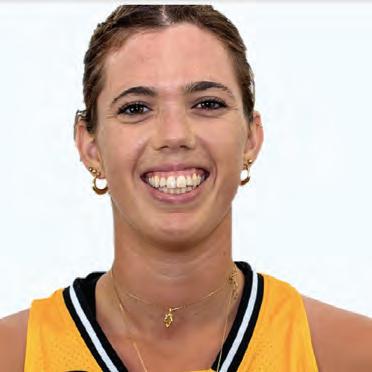
of Jewish teens from around the world to compete in Pittsburgh.
The timing is also perfect “to shine a light on girls and women in sports,” Block said, “because they are having a moment unlike anything we’ve ever seen. They’re soaring.”
Halevi, 27, grew up on Kibbutz Tirat Zvi in Israel’s Beit She’an Valley and was 15 when she began playing basketball in Israel, rising through the ranks to compete on the U16, U18, U20 and elite women’s national teams in both 5x5 and 3x3 formats. She helped her 3x3 national team win bronze in the U18 European championship, and eventually joined the women’s national teams in both 5x5 and 3x3 formats. She also played professionally in the Women’s National
First League before being drafted into the Israeli army.
Representing Israel on the world stage was a source of pride, said Halevi, who just completed her latest contract. “I say, ‘Yes, I am Israeli’ everywhere I go. I am always honored to wear the team jersey, and I tear up when they play the Israeli national anthem.”
Halevi played four years for the University of Wisconsin-Milwaukee, where she majored in marketing and earned an MBA, and was the only Jew on the team, which provided an opportunity to bridge cultural divides, she said.
“I’d describe how Friday night dinner is like having Thanksgiving every week, and how on a kibbutz it’s normal to knock on a door and ask for milk. You share everything, like one big family. I’d explain why I don’t drink milk with meat, and if I jumped a little when an ambulance would pass, why it sounds different to me as an Israeli.”
Some players were open-minded, she said. “With others, it was more of a challenge.”
Halevi moved to Pittsburgh in May and now works as the marketing manager for a healthcare and life sciences consultant. She is considering playing in Israel again and is keeping up her skills with pickup games at the JCC. Having grown up playing volleyball with boys on the kibbutz, she is comfortable competing with men, she said.
“Sometimes when I walk in they’ll give me a funny look, like ‘why are you here,’ but then once I start playing, they’re like, ‘wow,’ and they want to pick me for their team.”
Although she grew up playing sports for fun, once Halevi joined a national team, she turned her work ethic as a former kibbutznik to her competitive advantage.
“I knew I had to stay in the gym to be one of the best,” Halevi said. “I knew if I wasn’t there someone else would be working on shots or defense, so I put in extra hours.”
She has a “sky’s the limit” attitude and emphasizes the importance of family and friends. “When you have good people around you they will help you get the best out of yourself.”
Spector Angelo, now 60 and CEO of Compass Business Solutions, also emphasizes the importance of family, having grown up in a culturally strong, observant household in Buffalo, where she was supported in her passion for gymnastics.
“Life is about relationships and the values you have,” said Spector Angelo, who lives in the North Hills and has three grown children, including a daughter who made aliyah a year ago. “Relationships with friends, family, mentors, coaches and anyone else who helped you along the way make you able to do what you do.”

Yeshiva:
Continued from page 1
that Lubavitch congregants must vacate the building at the time previously agreed upon when school/camp is in session.
Despite Yeshiva’s delisting, the organizations continued to negotiate and eventually reached an agreement on all matters related to the original Perpetual Cooperation Agreement, which led to Yeshiva rejoining Merkos L’Inyonei Chinuch.
“Yeshiva,” Oster said, “worked tirelessly over the past several years to resolve our disputes with Lubavitch Center with the aim of alleviating the financial and operational challenges they created.”
He said Yeshiva’s leaders are “thrilled” to put the disputes behind them.
Pitt:
Continued from page 1
“But we’re charged by the chancellor with what she wants us to look at, what she wants us to do, and we will be issuing a report at the culmination of our process that will be public,” she said.
Recommendations of the working group will fall under the purview of the Office for Institutional Engagement and Wellbeing, according to Jared Stonesifer, senior director of external communications for the university. He said the Working Group on Antisemitism is engaged in analyzing and addressing antisemitism on campus and in the broader community.
“As part of its work, the committee will evaluate university procedures, programs and support systems aimed at combating antisemitism and explore opportunities to improve their development, implementation and enforcement,” Stonesifer said. “It will consider the impact of off-campus actors and events on the experiences of students, faculty and staff and identify ways for Pitt to collaborate with community organizations and initiatives to foster a safer and more welcoming environment for all.”
Pitt’s porous borders and location across the city’s Oakland neighborhood make it open to off-campus actors not affiliated with the university. In 2024, pro-Palestinian, anti-Israel and antisemitic protestors encamped at the Cathedral of Learning, allegedly vandalizing property and attacking
Athletes:
Continued from page 15
Spector Angelo came to gymnastics late, having started at age 10, and it quickly became “an obsession,” she said. “I loved the feeling of floating, flying, twisting, and dancing.”
Despite the rigorous training, which consumed most of her days growing up, it never felt like a hardship, she said. “I developed excellent self-management skills and self-discipline. I was extraordinarily goal oriented.”
Calling being Jewish “the compass in my DNA,” she is grateful to have been able to compete at a time “when Communists ruled
“We look forward to continuing to work together in good faith to resolve the remaining matters in a manner that upholds the values of Chabad,”
―Rabbi Yisroel Rosenfeld
“We can now sharpen our focus on providing a world class, dual curriculum education for Chabad families,” Oster said.
Rosenfeld said that with the help of a mediator, Lubavitch Center and Yeshiva “successfully addressed several points of dispute and are
encouraged by the progress made.” Yeshiva Schools’ commitment to remove all matters from secular court and resolve every issue not finalized by the mediator in a beis din led to its reinstatement as a Chabad institution.

law enforcement officers.
Unable to discuss specifics, Blee said the working group is taking what she called a “wide scope.”
“It doesn’t mean we’re going to make recommendations on every possible issue, but we are looking broadly at what all the possible issues that we might want to consider and learn about,” she said.
Stonesifer said the safety and well-being of the university’s students and community members is a priority embedded in everything Pitt does, and the university is concerned about safety “in every sense of the word.”
gymnastics,” she said. “As a Jew I wouldn’t have had the opportunity in certain countries as I did here.”
Spector Angelo was recruited to Division 1 Pitt, where she received a Blue-Gold award for excellence as a student athlete, and where her name is inscribed in the walkway to the Cathedral of Learning.
She went on to earn an MBA at the University of Massachusetts at Amherst, where she coached gymnastics, developing skills that helped lay the groundwork for her career in human resources consulting.
She was eight months pregnant when she founded her firm in 1997.
“My gymnastics and coaching shaped the way I work with clients, and, just as
“We look forward to continuing to work together in good faith to resolve the remaining matters in a manner that upholds the values of Chabad,” he added. Yeshiva Schools of Pittsburgh was founded in 1943 under the auspices of Tomchei Tmimim. It later became affiliated with Merkos L’Inyonie Chinuch, which provides professional guidance and services to existing Chabad schools. It also assists in the establishment of new schools and provides professional training for educators. Additionally, it maintains a directory of all Chabad educational institutions in the Englishspeaking world. PJC
David Rullo can be reached at drullo@ pittsburghewishchronicle.org.
from the suspension at a hearing scheduled on Aug. 28.
In March of this year, the Anti-Defamation League awarded the university a “D” on its Campus Antisemitism Report Card.
A month later that grade was revised to a “C.”
Stonesifer said that Pitt has worked closely with Jewish organizations, campus groups and law enforcement at the local, state and federal levels to ensure a coordinated responsive approach to the physical safety of its Jewish community. The university’s police department, he added, continues to provide security escorts for Jewish students, faculty and staff attending religious services and gatherings.
The safety of Jewish students and the environment on campus has been a concern for many in the community since Hamas’ invasion of Israel on Oct. 7 and the Jewish state’s response. Jewish students have been physically assaulted on and around the university’s campus, antisemitic events have been reported inside the School of Medicine and groups like Students for Justice in Palestine at Pitt have created an atmosphere making some Jewish students feel unwelcome.
SJP was suspended earlier this year for what the university said was violations of its policies. SJP is seeking injunctive relief
importantly, with my team,” Spector Angelo said.
“The work we do is around the employee experience. We think of the human resources person as a head coach whose role is to recruit and develop talent to win for their team.”
She especially enjoys executive coaching, she said. “I love working with people one on one to help them maximize their strengths and unleash their potential.”
Anyone can learn to think like an elite athlete, she said.
“I want people to push themselves and to know it’s OK to fail as long as they don’t get stuck. I encourage people to dream and see where it takes them.”
Maya Ennis was traveling and couldn’t
The university, Stonesifer said, also offers support to Chabad at Pitt and Hillel Jewish University Center of Pittsburgh. He noted that administrators meet regularly with Jewish students to stay informed about safety concerns and to address specific issues. Pitt, he said, has shown a strong commitment to battling antisemitism, not only through the working group, but through education and training with groups like the American Jewish Committee and StandWithUs.
As for the addition of the Antisemitism Working Group, Blee said she’s certain it’s “committed to making recommendations that will make positive impacts on campus.”
PJC
David Rullo can be reached at drullo@ pittsburghjewishchronicle.org.
be reached. She spent nine years as a gymnast before she began diving for the North Allegheny School District at 14. She earned many awards individually and with her team while at North Allegheny and was then recruited by Yale University for its women’s swimming and diving program. She competed until she graduated this past spring.
The evening also will include Kristen Keller, immediate past chair of Federation’s Women’s Council, receiving the Natalie E. Novick Award for her commitment to the Jewish community through volunteerism and philanthropy. PJC
Deborah Weisberg is a freelance writer living in Pittsburgh.
By PJ Grisar | Forward
We meet the Schwooper family — whose name is a portmanteau of Schwartz and Cooper — on a motorcade to a burial in 1996. For many Jews, it may feel like a homecoming.
The matriarch, Naomi, is bereaved for the loss of her mother but maybe more annoyed by the rabbi’s Mad Libs-style eulogy. They’ve lost track of the hearse and the children bicker in the back. Naomi quickly shuts down the idea that Bubbe has been reunited in death with her husband, but as the children reel from the concept of no afterlife in Judaism, a different perspective is introduced.
Jews focus on the here and now, the Schwooper patriarch, Elliot, adds: “You don’t leave a good, meaningful life for some reward later. You live a good, meaningful life so that you lead a good, meaningful life.”
In these opening moments, “Long Story Short,” the new Netflix animated series by “Bojack Horseman” creator Raphael Bob-Waksberg, lays out its major theme: What it means to live a full life, and, as a corollary, a Jewish one. (Spoiler: there’s no one way to do it.)
“I wanted to tell a story that was unapologetically Jewish without feeling the pressure to do the things that a Jewish show might have to do or address,” said Bob-Waksberg, who grew up

in a very Jewish milieu in Northern California (day school education; mom owned a Judaica store; father resettled Soviet Jews). “And the only way I know how to write Jewish is to write in the way that I understand it and the rhythms of my family and the people that I know.”
While not really autobiographical, Bob-Waksberg hopes the series, told non-linearly with episodes set in the ‘90s, aughts and 2020s, sparks recognition. But it doesn’t hurt if you know from Jews.
Its plots involve a row over a candle for a deceased relative at a bar mitzvah (prompting the tearing of a $108 check to the ADL); baking knishes for a potluck for prospective parents at a day school (for children named Walter and Benjamin); a fib that leads to an epiphany during Yom Kippur Viddui confession (and
a joke about the distinction between Litvaks from Vilna and ones from Vitebsk).
Bob-Waksberg anticipates many will see themselves in this lovingly flawed, supremely Semitic family, which is also queer, Black and interfaith, Conservative, Orthodox and non-affiliated.
“I think people might even be surprised by the ways in which they can relate to characters that maybe on paper, don’t seem like them at all,” he said.
I spoke with Bob-Waksberg over Zoom about how becoming a parent inspired the show, being unafraid to go deep on Yiddishkeit and the animated Jewish Easter eggs (er, afikomen) hidden in the backgrounds. The following conversation has been edited for length and clarity.
PJ GRISAR: What inspired you to tell this kind of a story, more rooted in reality than your previous work, and obviously quite a bit more explicitly Jewish?
RAPHAEL BOB-WAKSBERG: Part of it was I had kids since my previous work. When you become a parent, you think about family more and in different ways, thinking about “What choices am I gonna make for my kids, and how am I going to raise them?” I think about the way I was raised, and what from my parents do I want to emulate, and what from my parents do I want to correct — knowing that I will not get it 100% in either direction and I’m gonna screw things up!
I was thinking about family a lot, and then thinking about all the ways that identity connects to that, whether that’s Jewish identity, or your identity as a son versus as a father or a brother or a spouse, and how you define yourself, and the way that that is defined for you a little bit by your family, and how you might try to escape that or embrace it.
And of course, we see how each of the siblings relates to that tradition. It begins and ends with this question of what it means to be a Jew. Did the process of the show change the way you thought about that idea?
I think this show has actually been really helpful for me in articulating some of these thoughts that I’ve had. But because it’s not an essay, I don’t have to decide anything. I can kind of explore it. I can have these conversations through my characters.

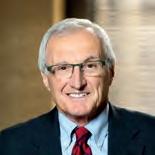




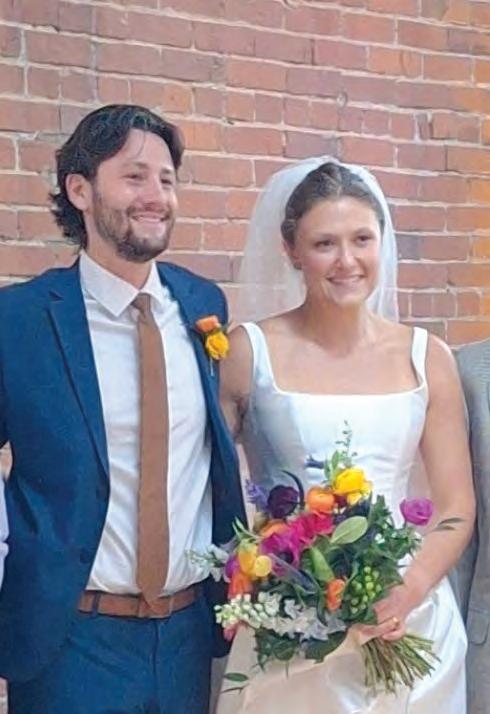


Brayden Matthew Markovitz, son of Bryan and Alina Markovitz and older brother to Brody and Carter, will become a bar mitzvah at Beth El Congregation of the South Hills on Aug. 23, 2025. Grandparents are Jeff and Randi Markovitz, and Yuriy Rosenberg and Irina Milyavskaya.
Julie Stern and Jon Olbum are delighted to announce the marriage of their son, Jeremy Olbum, to Anna Wears, daughter of Margaret Palmer and Peter Wears. Jeremy and Anna were married in Pittsburgh and are living in Pittsburgh. PJC

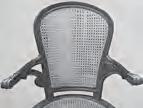







Rabbi Mark Asher Goodman Parshat Re’eh Deuteronomy 11:26-16:17



I’ve had the distinct blessing over the summer of teaching beginning and intermediate Hebrew to folks who have never mastered this alphabet and un-voweled language before now. It has been surprisingly rewarding and fascinating to watch other people go through the process of acquiring and absorbing the letters, sounds, syllables and words — to be reminded, well after I originally learned Hebrew in elementary school, that it’s
for prayer and study. And Hebrew letters, with their waves and curves and crowns, have a beauty all their own, too.
In this week’s parsha, there is a small word used in one line, and not used in another, and it becomes a moment for the Chernobyler Rabbi, Menachem Nachum Twersky, to explore the Kabbalistic meaning of the letters of Hebrew. In Deuteronomy 11:26-28 it says, “I set before you today blessing and curse: THE [et] blessing, if you obey the commandments, and curse, if you do not obey the commandments.” So the word “the,” or “et” appears for blessing, but not for curse.
The Chernobyl rabbi in his masterwork “Meor Eynayim” notes that the word et — “the”
easy to mix up resh and dalet, and that a patach under a hey at the end of the word makes the sound ha but a patach under a chet makes the sound ach, and a dozen other rules. Hebrew is hard. It conceals lots of deep understanding, but with work, it reveals big ideas and profound insights. It is mysterious and wonderful.
It’s also fun to show students a claf of a mezuzah or a page of the Torah and have them ask “Why do some letters have little decorations?” And to chuckle and tell them, “Those are called crowns. According to tradition, Moses asked God the same question.” And then to tell them the wonderous story of Moses in Rabbi Akiva’s house of study. (Google it. It’s in Talmud Menachot 29a.)
Forming letters of any kind into words and sounds, language — and here I mean any language, and any alphabet — allows humans to express themselves to other humans, in words or in writing. This is a gift that was not given to all other species. But Hebrew is believed in our tradition to have a spiritual dimension beyond that of other languages, which is why it is used
— is made up of an aleph and a tav — the first and last letters of the Hebrew alphabet. And then he quotes an idea in the Zohar — the central mystical book of Judaism — and says, “The Creator, Blessed Be, contracted God’s self into the letters.” Meaning, God is present in all of the Hebrew letters, aleph through tav. And that’s why the word et appears in the verse about blessing, and not in the verse about curse — that God wants to remind us that God is present in the blessings God gives us and prefers that we not invoke the curses.
And this is further a reminder that Hebrew is more than language — it is our connection point to the Divine, if we chose to learn, pray and explore the mysteries that both Hebrew and God have to offer. PJC
Rabbi Mark Asher Goodman is rabbi of Brith Sholom in Erie, Pennsylvania, and associate rabbi of Congregation Beth Shalom in Pittsburgh. This column is a service of the Greater Pittsburgh Jewish Clergy Association.

AVERBACK: Nancy McKee Averback, 91, passed away peacefully on Aug. 12, 2025, in Bradenton, Florida. She left Pittsburgh four years ago when her husband of 64 years, Robert (Bob) M. Averback, passed away. She was born on Sept. 18, 1933, in Punxsutawney, Pennsylvania, to Bion and Beatrice McKee. She is survived by three daughters, Susan (Averback) Leff (Louis), Ann Averback (David Gault) and Lynn Averback (Roger Krusen). She is also survived by two grandchildren, Mara (Leff) Koperwas (Matthew) and Samuel Leff (Grace), and one great-grandson, Robert (Robbie) Koperwas, all of whom she adored. Nancy was a nurse and practiced for over 55 years in various capacities including surgical, hospice and home health. She was an avid Steelers fan and loved all Pitt sports.There will be a private memorial service to be determined. Any donations can be made to: The Freedom Village Memorial Scholarship Fund,6406 21st Avenue W., Bradenton, Florida 34209. A Ralph Schugar ChapelService. schugar.com
COHEN: Mira Manes Cohen, on Aug. 12, 2025, died peacefully at home. She was born on Oct. 29, 1945, and was the daughter of the late Allen and Ann Manes. She was preceded in death by the love of her life, Sanford E. Cohen. She loved spending time and kibbitzing with her good friends. Nothing brought her more joy than spending time with family. She was of course happiest with visits from her children, Brian Cohen and Nicole (Howard) Valinsky, grandchildren Alex, Andrew (Danni), Brad, Eric and Shayna, and of course, her great-grandson Milo. As her kids were growing up, she would always be so welcoming to all of their friends, who would lovingly refer to her as “Mrs. C.” Graveside service and inter ment were held at Beth Shalom Cemetery. Contributions may be made in her honor to Community Day School or Congregation Beth Shalom. Arrangements entrusted to Ralph Schugar Chapel, Inc. schugar.com
D OBKIN: Dr. Larry A. Dobkin, on Monday, Aug. 18, 2025. Beloved husband of Sharon Weiss Dobkin of Pittsburgh (formerly of Beachwood, Ohio); very loving and proud father of Rachel (Ben Eisenstein) Dobkin of Brookline, Massachusetts; brother of Joseph Dobkin of Miami, Florida. Also survived by several cherished cousins and dear friends. A graduate of Taylor Allderdice High School, Larry majored in chemistry and graduated magna cum laude from Brown University. After graduating from University of Pittsburgh School of Medicine, Larry practiced internal medicine and geriatrics, taking calls from home, making house calls and providing an unsurpassed level of care and expertise to all he served. Humble, unassuming and quiet, Larry had a wealth of fascinating stories which he remembered with extraordinary detail. A math genius, Larry loved baseball and was an amateur baseball statistician. He was also legendary for being able to balance his



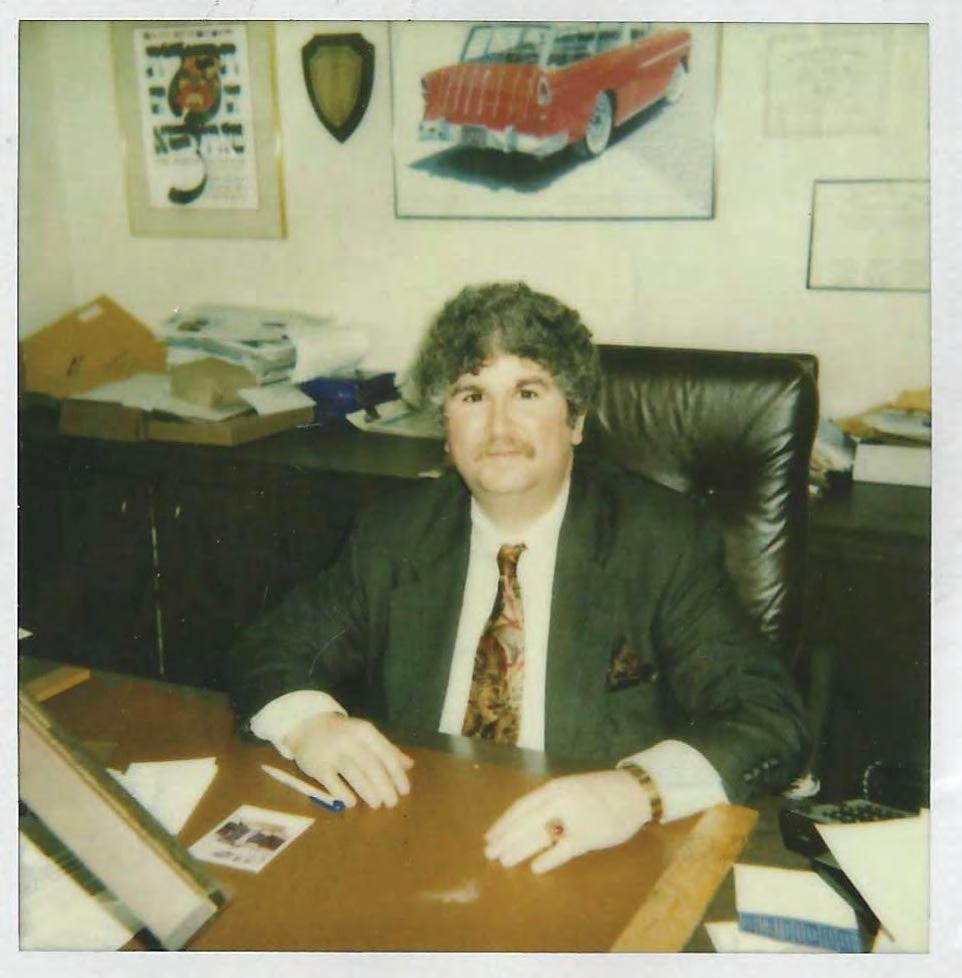

“Our greatest glory is not in never falling, but in rising every time we fall.”








Lee & Lisa Oleinick

checkbook in his head to perfection. Larry loved teaching and mentoring; he loved dogs, especially his beloved Lucy, music and classic cars. He was kind, caring, generous and down to earth. There was no one like him and he will be terribly missed by his loving family, devoted friends and patients. Services were held at Ralph Schugar Chapel, Inc. Interment Beth Shalom Cemetery. Contributions may be made to the Parkinson Foundation of Western ), Congregation Beth Shalom, 5915 Beacon Street, Pittsburgh, PA 15217 and michaeljfox.org).

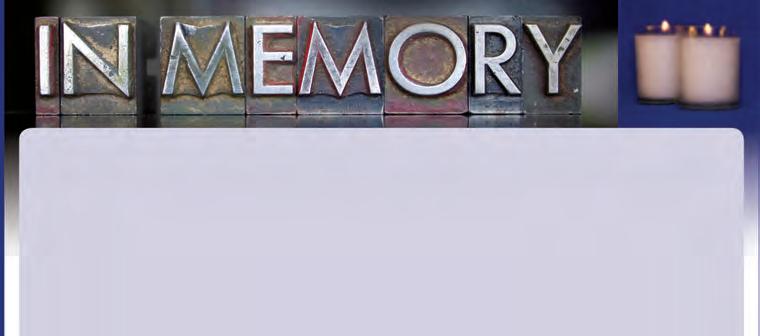
Bernard Dickter
Joan Finkel
Sherwin E Glasser
Marjorie Halpern
Marjorie Halpern
Phyllis D Katz
Phyllis D Katz
Jeffrey L Kwall
Harold & Cindy Lebenson
Sanford Middleman
Frank Rubenstein & Laura Goldsmith .Hinda Kuhl Rubenstein
Edith Flom Schneider .Peter Michael Oresick
Bernard S & Mark J Shire Etta Borof Ontville
Eileen Snider & Family Alisa Chotiner
Sharon Snider .Alisa Snider Chotiner
Sharon Snider . Howard S Snider
Dr Susan Snider & Family Alisa Chotiner
Dr Susan Snider & Family Howard S Snider
Mitchell Toig Morris Toig
David Wolfson .Isadore Sydney Wolfson
Sunday August 24: Judge Samuel J Feigus, Sherman Hershman, Stuart Irwin Holtzman, Joseph Kossis, Celia S Landay, Simon Miller, Peter Michael Oresick, Ruth Pattak, Morris Rosen, Ann F Schwartz, Benjamin Schwartz, Isadore Louis Sigal, Dorothy B Solomon, Harry M Solomon, Bessie Stein, Maurice Louis Swartz
Monday August 25: David Bass, Gertrude Chotiner, Leopold Diamond, Louis Farber, Sadie Friedlander, Louis Friedman, Milton S Gordon, MD, Rose Grace Halpern, Alihu Klein, Raschel (Ray) Levine, Anna Rabinovitz, Hinda Kuhl Rubenstein, Alisa Snider Chotiner, Samuel Verbin, Adolph Wirtzman
Tuesday August 26: Joseph Cooper, Max Eger, Louis Eisenfeld, Meyer Fiman, Pearl Greenfield, Abraham Pittler, Charles Shapiro
Wednesday August 27: Sarah Americus, Alan Herbert Azen, Annie Berezin, Samuel Berger, Isadore A Bernstein, Susan Dickter, Rebecca L Guttman, Anne Harris, Mary Garson Mazer, Marie G Mundel, Louis Rosenbloom, Eli Spokane, Morris Toig, Louis Whiteman
Thursday August 28: William Americus, Tillie Bennett, Samuel W Berk, Zelda Glantz Chasick, Alex Glantz, Howard W Jacobson, Mollie Kurtz, Sara Melnick, Sharon Lee Morton, Milton Moskovitz, David Pearlstein, Rose Rom, Alex Ruben, Fannie Shapiro, Leo Spiegle, Harry Treelisky, Louise Ziskind
Friday August 29: Lillian Bergad, Florence Bertenthal, Fannie Cohen, Patty Danovitz, Lena Darling, Rose Gold, Dora F Greene, Bernard J Harris, Jeanette Miller Horowitz, Leah Katz, Pearl Laufe, Selma G Leventon, Natalie Myra Lewis, Harry Malkin, Laura Marcuson, Rabbi Pincus F Miller, Stefanie Ann Miller, Sylvia Monsein, Harry L Richman, Max Roth, Gwen Amy Shakespeare, Howard S Snider, Oscar Wilson, Isadore Sydney Wolfson
Saturday August 30: Anna Friedman Calig, Rose Calig, George H Danzinger, Ella Friedman, Edith Goldstein, Liuba Horvitz, William M Katz, Marcel Lucja, Frank Miller, Frances Rosen, Benjamin David Schwartz, Becky Weiner, Annie Wirtzman, Nathan Zapler
By Aaron Bandler | JNS
Elon Dershowitz, a film and podcast producer and the son of attorney and longtime Harvard University law professor Alan Dershowitz, died on Sunday. He was 64 years old.
The cause of death was a stroke, according to his family.
“We were very close,” Dershowitz told JNS. Elon was the producer of his podcast “The Dershow.”
He explained that at the age of 10, Elon was diagnosed with a brain tumor and told that he wouldn’t live to see his bar mitzvah.
“He’s had 52 years since that time, and he’s lived a full life and made these great movies,” his father said. “He struggled because he had that situation, which left him not being able to read or see, but he made up for it with his hard work.”
Elon’s mother, Sue Barlach, died in 1983.
Elon graduated from Hampshire College in Amherst, Massachusetts, and subsequently worked in the audiovisual department at Harvard Business School, according to his family. He later moved to Hollywood, California, and then to New York City.
He was the co-producer of the 1990 Oscarwinning film “Reversal of Fortune,” starring Glenn Close and Jeremy Irons, who won an Oscar and a Golden Globe for his performance in the film. It was the film he was most proud of, according to Dershowitz.
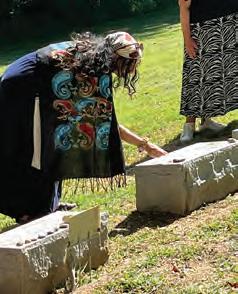

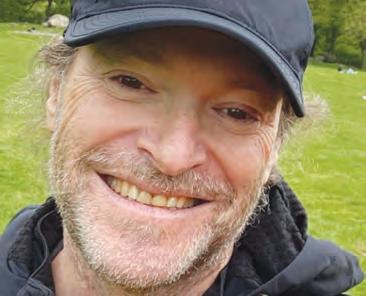
“He brought it to Hollywood,” Dershowitz said. “He went around shopping it. He persuaded the company to do it. He helped pick the stars. He was a very important part of that film.”
Other movies Elon produced included Oliver Stone’s 1987 film “Wall Street,” starring Michael Douglas and Charlie Sheen; the 1988 film “Talk Radio”; the 1998 film “Fallen,” starring Denzel Washington; and the 1997 TV movie “The Advocate’s Devil.” Elon also co-produced the ESPN television series “Break Up the Bombers,” “Whose Curse is Worse?” and “Pete Rose on Trial.”
His favorite filmmakers included Woody Allen and Mel Brooks, according to his father.
“He loved comedy. He himself did a little stand-up comedy, and he loved good comedians, and he hated bad comedians, which there are many on television,” Dershowitz said.
At a younger age, Elon performed as an amateur magician under the name “Elon the Pretty Good.” He performed for the Boston
Celtics; the late Sen. Ted Kennedy (D-Mass.) and his staff; and gave nightly shows at a Legal Sea Foods restaurant bar, said his family.
Dershowitz explained that Elon started performing magic while undergoing radiation treatment for his brain tumor as a means of entertaining children who were also undergoing the same treatment.
“ That’s how he really started his career as a magician: entertaining other kids,” he said.
Another one of Elon’s passions was sports. He was a season ticket-holder for the Los Angeles Lakers and a co-season ticket-holder with Dershowitz for the Celtics, according to Dershowitz. The two got to go into the locker rooms for various championships won by the Celtics and the Boston Red Sox.
‘He was with me all the time’
“He loved Israel,” Dershowitz told JNS, recalling that his last trip with Elon was to Israel after the Hamas-led terrorist attacks in southern Israel on Oct. 7, 2023, where they visited sites of the massacre.
“He was very much a part of my Jewish life,” Dershowitz said. “He went with me to the Soviet Union to help represent dissidents, he
went with me to Egypt when I was negotiating with the Egyptians, he went with me to China — he was with me all the time.”
Elon would send his father TikTok videos about Israel regularly and ask him for sound responses to defend the state of Israel, Dershowitz said.
Dershowitz described his son as being “brave” and “determined.”
“Despite the fact that he really couldn’t read because he had an eye deficit, he knew more things than most people,” he said. “People thought he had read 100 books because he just had this instinctive ability to get information.”
He noted that Elon was an early user of the internet and artificial intelligence, “because he needed it. He would always be online getting information that he could get without reading a book. He figured it out. He figured out how to use his talents in a creative way.”
He added that Elon “was the kindest person you have ever met. That’s all he cared about, being kind to people.”
Indeed, said Dershowitz: “He was an amazing person. We’ll miss him every day.”














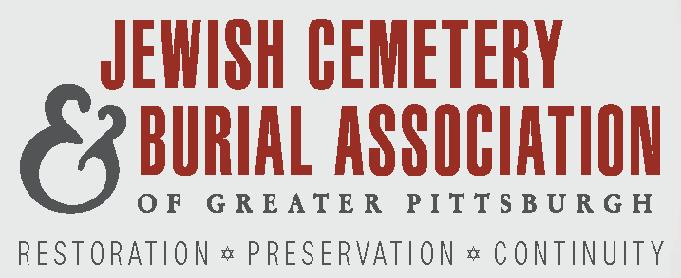
On Sunday, August 10th, the Jewish Cemetery & Burial Association of Greater Pittsburgh held a Community Unveiling at Chesed Shel Emeth Cemetery (free burial). In Jewish tradition, an unveiling is the formal dedication of a monument at the grave of a loved one, a moment to speak their name, recall their life, and mark their resting place with dignity. We dedicated monuments for four individuals who were buried over the past year, honoring their memory and ensuring their place in our collective story.
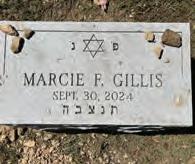





Following the unveiling, we held a Community Book Burial (Genizah). In Jewish practice, holy books, prayer shawls, and sacred writings (shaimos) that are worn or damaged are never discarded casually— they are buried with the same reverence as those who used them. is year, we respectfully buried an estimated 14 tons of shaimos from across Western Pennsylvania.
Our sincere thanks to the many individuals, congregations, and organizations who entrusted us with these sacred items, and to all who joined in this mitzvah of care, respect, and tradition.
We are grateful to all who attended, to our partners Ralph Schugar Chapel and Urbach Memorials, and to Rabbi Eli Seidman for leading both services with warmth and compassion.

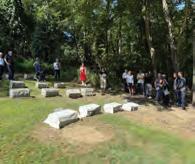
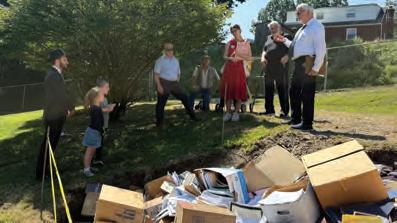


For more information about JCBA cemeteries, to volunteer, to purchase plots, to read our complete histories and/or to make a contribution, please visit our website at www.JCBApgh.org, email us at o ice@jcbapgh.org, or call the JCBA o ice at 412-553-6469.







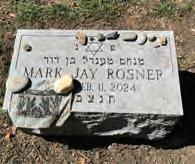



Contact me today to discuss all of your real estate needs!
Sherri Mayer, Realtor Squirrel Hill Office
C: 412-760-0412 O: 412-421-9121x225 sherrimayer@howardhanna.com HowardHanna.com






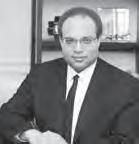





Smith-Rosenthal Team
Jason A. Smith & Caryn Rosenthal
Jason: 412-969-2930 | Caryn: 412-389-1695 Jasonasmith@howardhanna.com Carynrosenthal@howardhanna.com









































Bob-Waksberg:
Continued from page 17
But I remember when I was in fourth grade, I had this Judaica teacher, Riva, and we had this thing we did in class where the topic was, “What makes a Jew a Jew?” And she had this like puzzle of a person, and the different pieces had different Jewish attributes, like, “observes the holidays,” “keeps kosher,” “believes in God,” you know, “is married to a Jew.”
And she would take away the pieces one by one and go, “Is this person still a Jew? What about in this combination?” And I revisit that a lot. I think my answers have changed quite a bit since I was in fourth grade to what makes a Jew a Jew. And I’m not sure there is any one thing. I couldn’t define a Jew in a way that only includes Jews and doesn’t include any non-Jews. It kind of is a loose, “I know it when I see it, kind of thing,” while also acknowledging that people might know it when they see it differently than me.
Thinking about what Judaism is, and what Jewishness is, and what it’s for — what the purpose is — I am not someone who believes that we are doing this because the Torah tells us to do it, so we have to. I’m someone who believes that we choose to be Jewish, and that without being too transactional about it, we should get something out of it. And so I am constantly thinking, “Why do we do these things, and what is the benefit?” and that maybe sounds cynical, like there isn’t one, but I think if you watch the show, you might see maybe there is …
There’s a way that the show could have been sort of generically Jewish, or had like, kind of the flavor, or a whiff of a hint of Jewishness. What is your philosophy on bringing that specificity in here, not over-explaining things, making sure that it still resonates?
We had writers in a writers’ room who were Jew-Jews. We had writers in a writers’ room who were Jews, but maybe didn’t get all the day school references. And we had writers in a writers’ room who were not Jewish, who didn’t really know a lot of Jews, and everyone seemed to enjoy it. And that’s true in every stage of the process. We have actors on the show who get everything, and actors on the show who are like, “I’m along for the ride, and this is great.” And nobody has ever said “this is too much, or whoa, whoa, this is maybe not for me.” So we have kind of these checks and tests throughout the process.
But I always felt like when I’m watching something as an audience, I want to be dropped into that world, like I want just enough that I can try to keep up. That’s exciting for me. There are jokes on the show that I didn’t get at first, that had to be explained to me. I think it also helps make the family feel real that they have these inside jokes and references that maybe you’re not a part of. I think it makes it feel like, “Oh, these people really know each other. They have this common language.” And in my family, a lot of that stuff is Jewish-related. And I would hope that audiences wouldn’t be intimidated by that. But if they might be, I would say, don’t tell them? Let them watch the show and see for themselves.
You’re working with cartoonist Lisa Hanawalt again, like on “Bojack.” The aesthetic is very different. And also all these visual easter eggs that we see, obviously, like ketubot and menorahs.
I would say visual afikomen.
Visual afikomen, good punch-up. What was the idea?
From the beginning with Lisa, we were both very conscious of, we don’t want this to look like “Bojack.” I mean, obviously it’ll feel like it in some ways, because she does what she does,


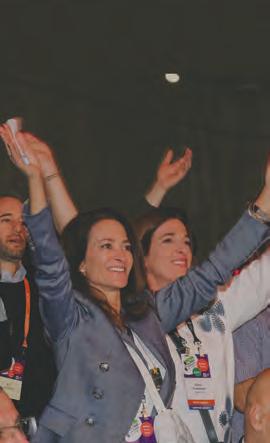
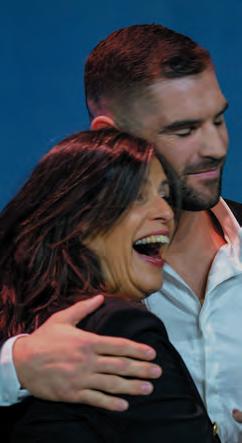
and I do what I do as a writer. But we didn’t want it to feel like Bojack himself could walk through the frame at any moment. We wanted it to feel like its own distinct world.
We talked a lot about how in our experiences in animation, both in making it and watching it, sometimes you get these very charming drawings and initial designs which then kind of go through the animation machine, and they end up feeling more flat and puppetty or perfect. And so we really were precious about, “Let’s hold on to the charm of the loose drawing. Let’s make this feel loose. Let’s let the characters move in a loose way. Let’s have the lines on the drawings not always connect. We can color outside the lines a little bit.”
I think they had a rule for the artists, no straight edges for drawing lines. Everything is done freehand. And then there’s some deliberate choices to make the perspective a little wonky in some places, or to make some characters’ heads a little misshapen, because, again, we wanted it to feel loose and visceral in that way.
Do you feel that there’s a need to tell Jewish stories like this?
I think that there is a wide diversity of Jewish life, and there are all kinds of Jews. And I think the more stories we tell, the more ways we can define ourselves, not as a bloc and as all one thing, the better it is for everybody. So yes, I’m really proud that on my show I can show some things that I haven’t seen a ton of in even Jewish stories, while also knowing that there are all kinds of Jews I don’t even touch on my show.
I had a driver the other day who was Iranian Jewish, and we talked about that and his experience. It’s like, “Yeah, I’m not using that now. Maybe at some point I will.” But I couldn’t possibly check down the list of every kind of Jew so I want to create opportunities for more



people to tell their stories, or for people to watch my show and go, “Well, that’s not really what my family was like. Let me tell that story.”
It returns to the lesson in the Judaica class. Something that’s so great about this, and I’m guessing that this is drawn from life a little, that phenomenon of cooperative overlapping is very much in this.
That is very much a choice on the show. The way we structure the dialogue, where we write it — most shows don’t do it like that. And the nice thing about animation is there are technical ways in which it is easier, because we record all the actors separately, and so we can actually, in the edit, make sure everybody is being heard the way we want them to be heard. They’re not actually talking at the same time. So we can inch someone back, like a half a second. We want to make sure this person gets this word in. We can take the volume out of this person. The levels are different, which gives us a lot of control. There’s a lot of dual dialogue in our scripts, and then often in the edit, we’ll be like, let’s squeeze it even more. She should not wait for him to finish his sentence before she starts talking. They should all be talking, multiple conversations happening at once. I get the gist of what you’re saying and I’m gonna respond. I don’t need you to get the period. And notice how I did that to you as you were asking the question.
Look, we’re two Jews talking, it’s gonna happen.
“Long Story Short” debuts on Netflix Aug. 22. PJC
This story was originally published on the Forward. To get the Forward’s free email newsletters delivered to your inbox, go to forward. com/newsletter-signup.











Join us at this pivotal moment in history as we come together for our land and people of Israel. Featuring visionary speakers, a powerful Israel Expo, and the nation’s largest Shabbat dinner, this isn’t just an event — it’s a movement. Unite. Inspire. Act.









Be part of the gathering where Israel’s strongest supporters chart the course for meaningful impact.










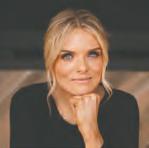
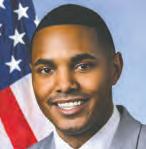
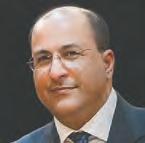


inar traversing Montgomery, Selma, Birmingham and Memphis. Participants explored the Civil Rights Movement while
Slurping up the season
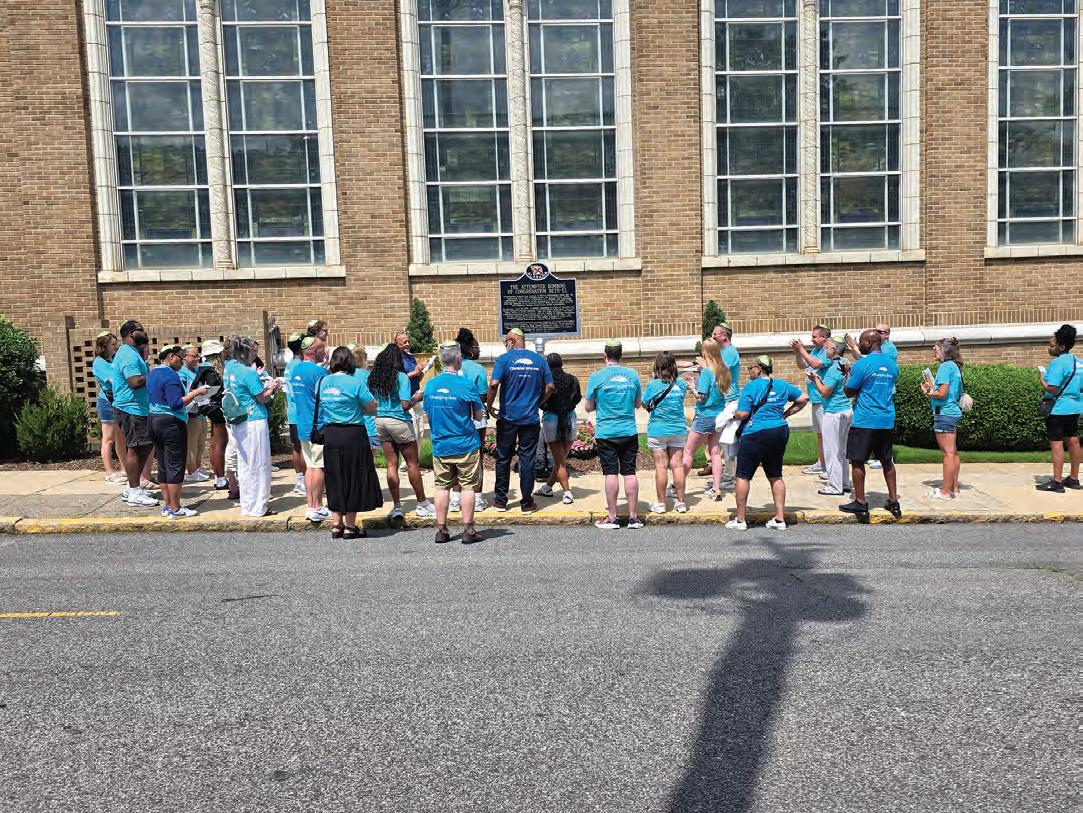
The air up there
Campers from Camp Gan Israel Squirrel Hill enjoyed a great day at Kennywood.
In an effort to beat the heat, Hillel Camp, a program of Hillel Academy of Pittsburgh, stopped for Slurpees.
Summer service
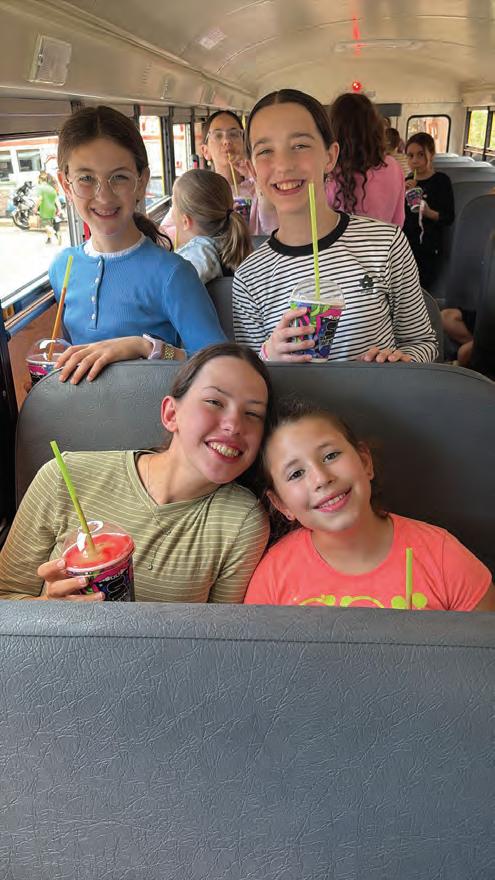
Camp Lion, a Community Day School-hosted summer camp, partnered with Our Giving Kitchen to prepare food for neighbors in need.

Chabad Young Professionals and Chabad of Monroeville members met for a spirited night at PNC Park. The evening kicked off with a kosher tailgate, conversation and tefillin wrapping before watching the Pirates win.


Ella Ziff was honored by Hillel Academy of Pittsburgh for 13ish day school. Ziff was celebrated for her “creativity, -
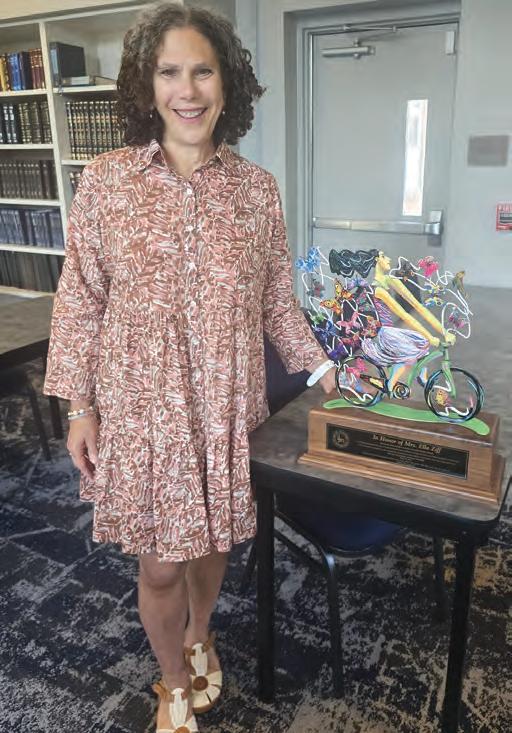

Pittsburgh Jewish Chronicle
6:00 PM -Reception Luai Ahmed 7:00 PM -Program
Location will be given upon registration Rona Kaufman

